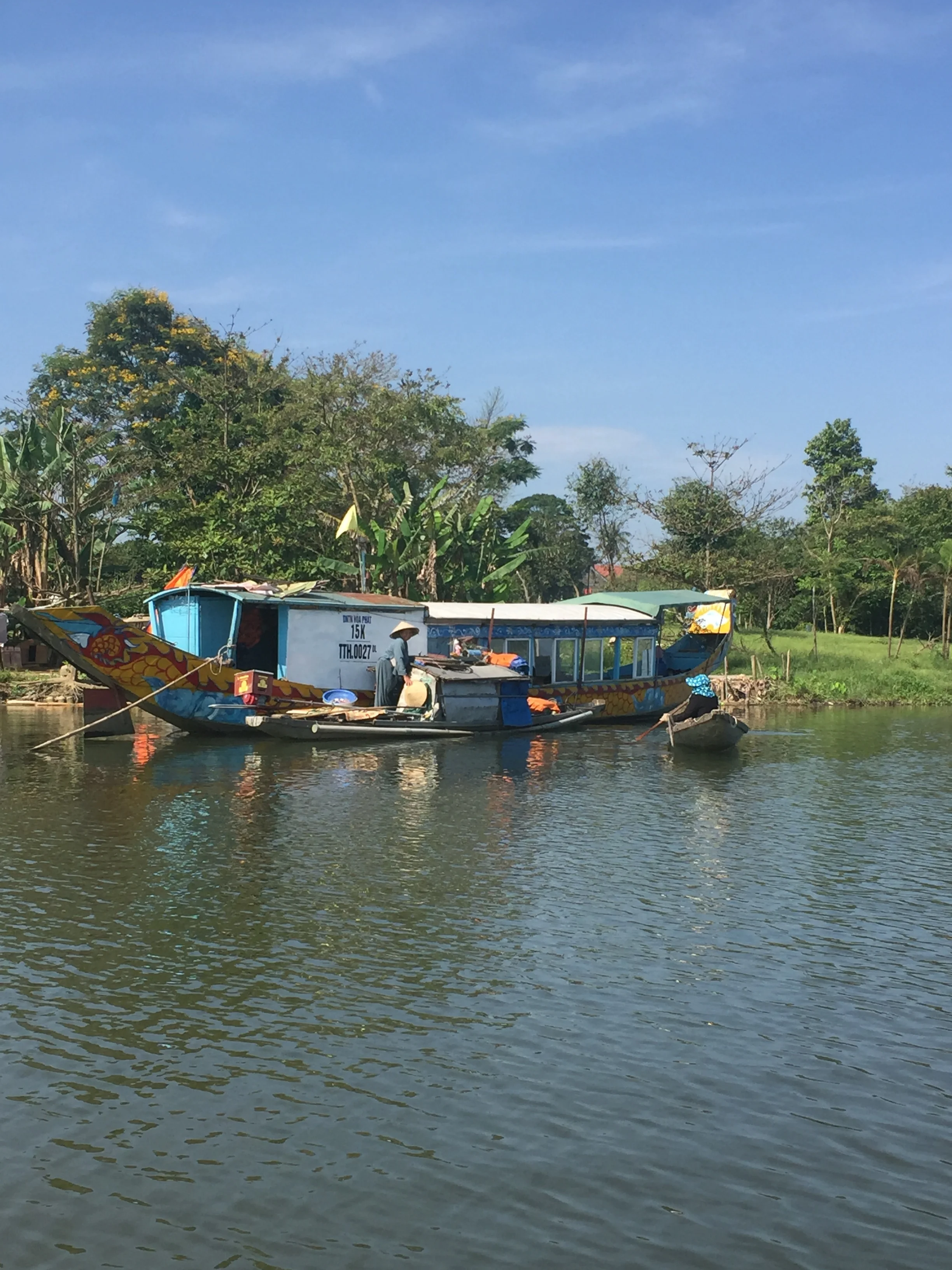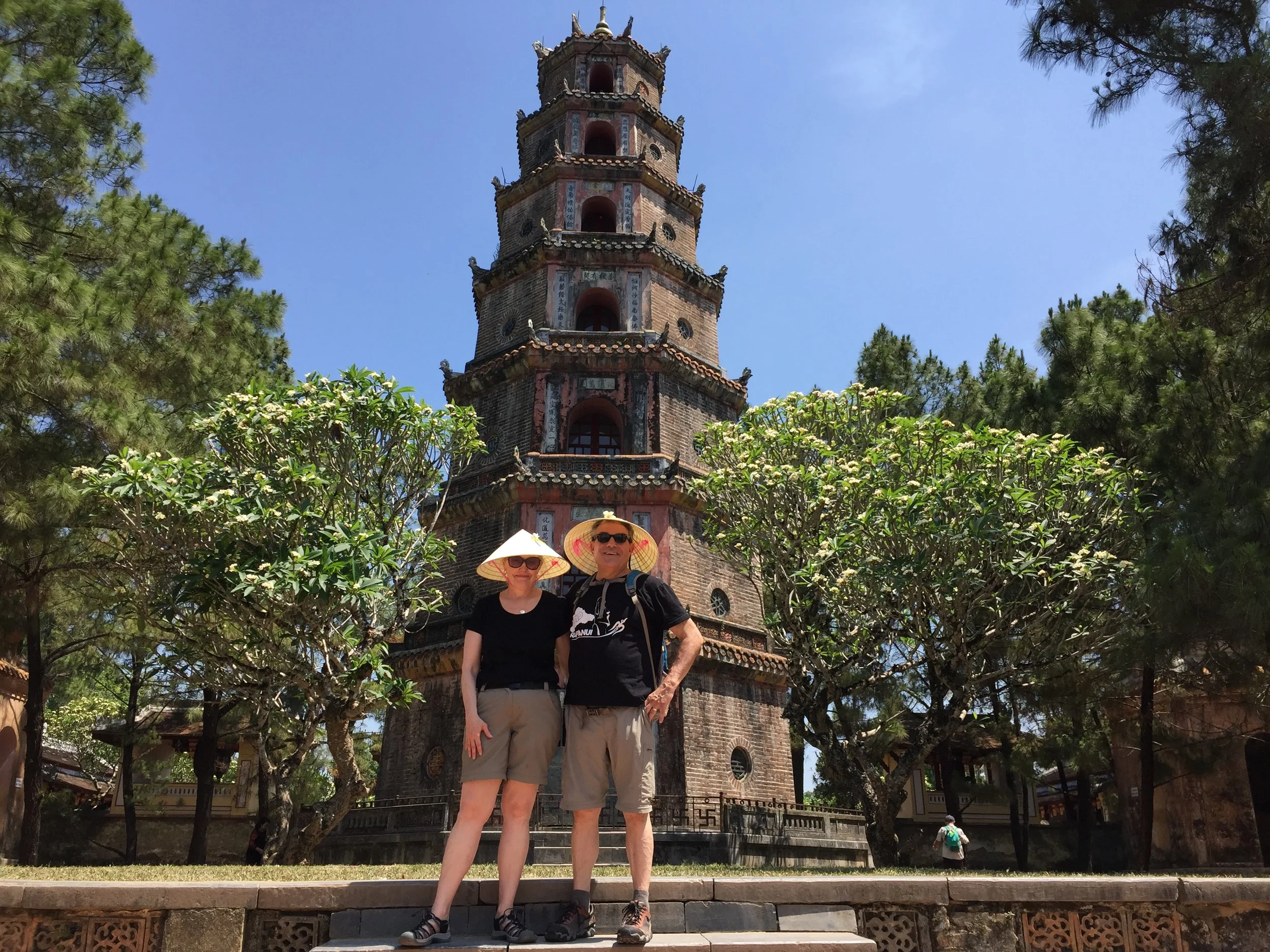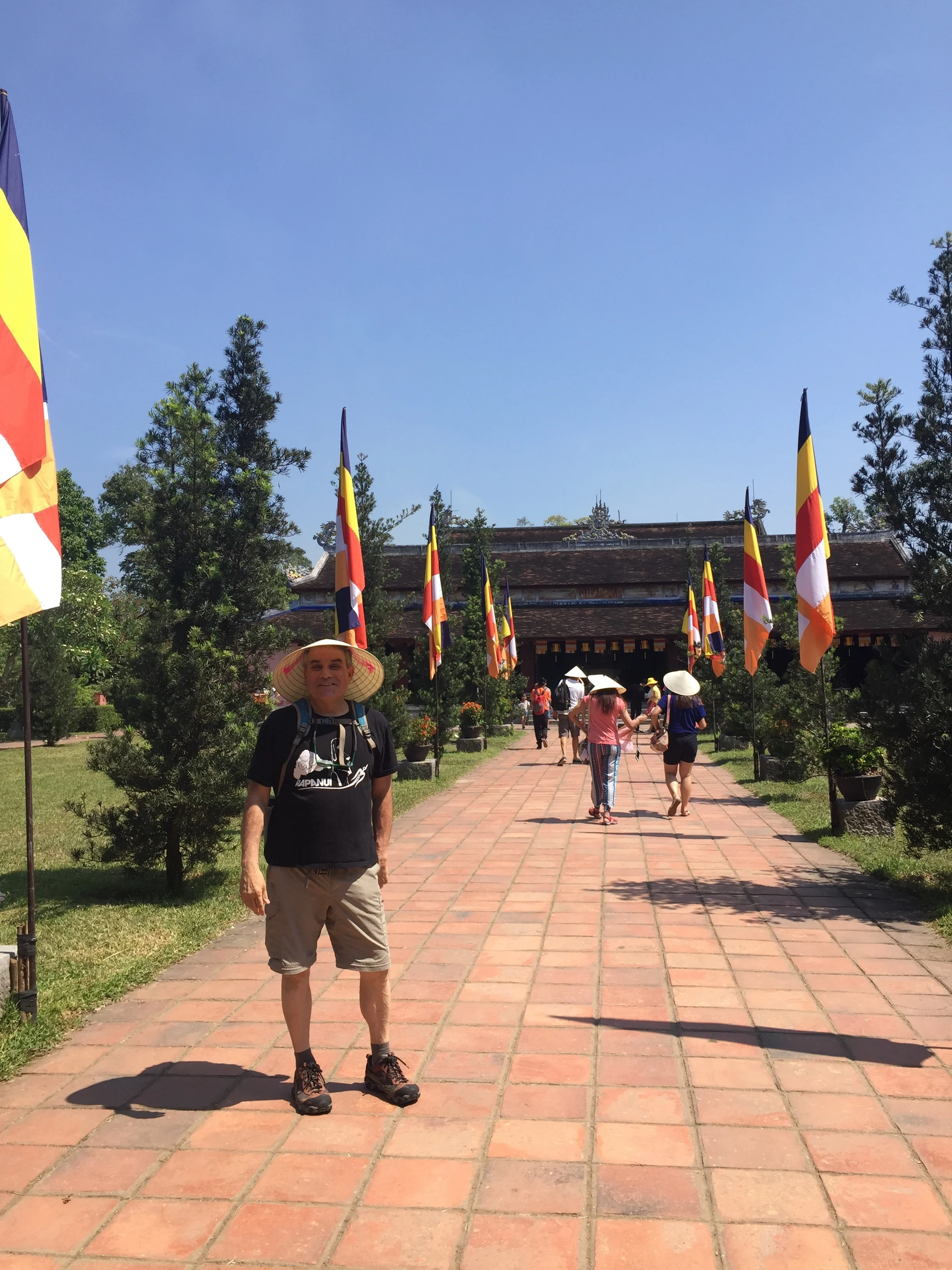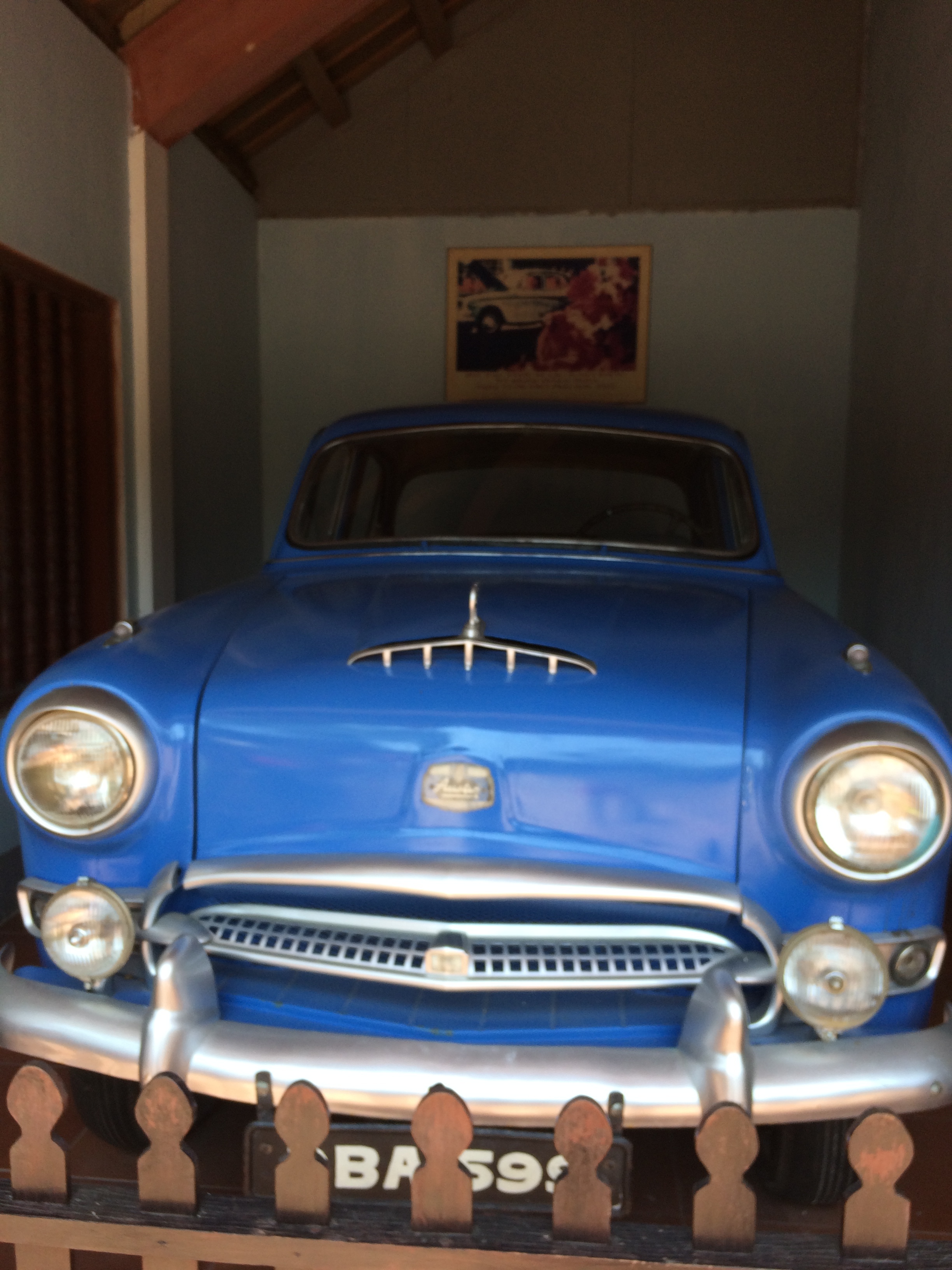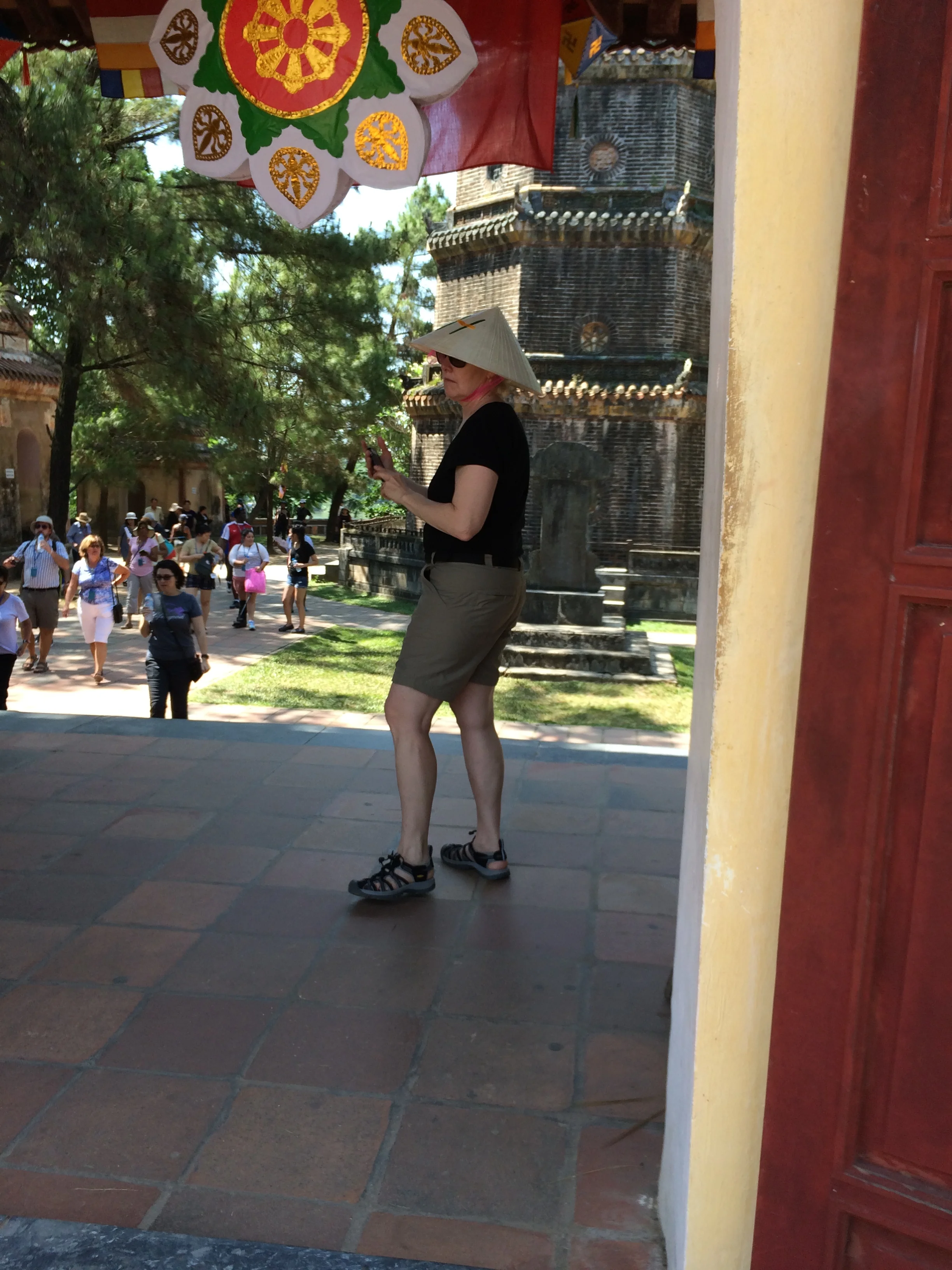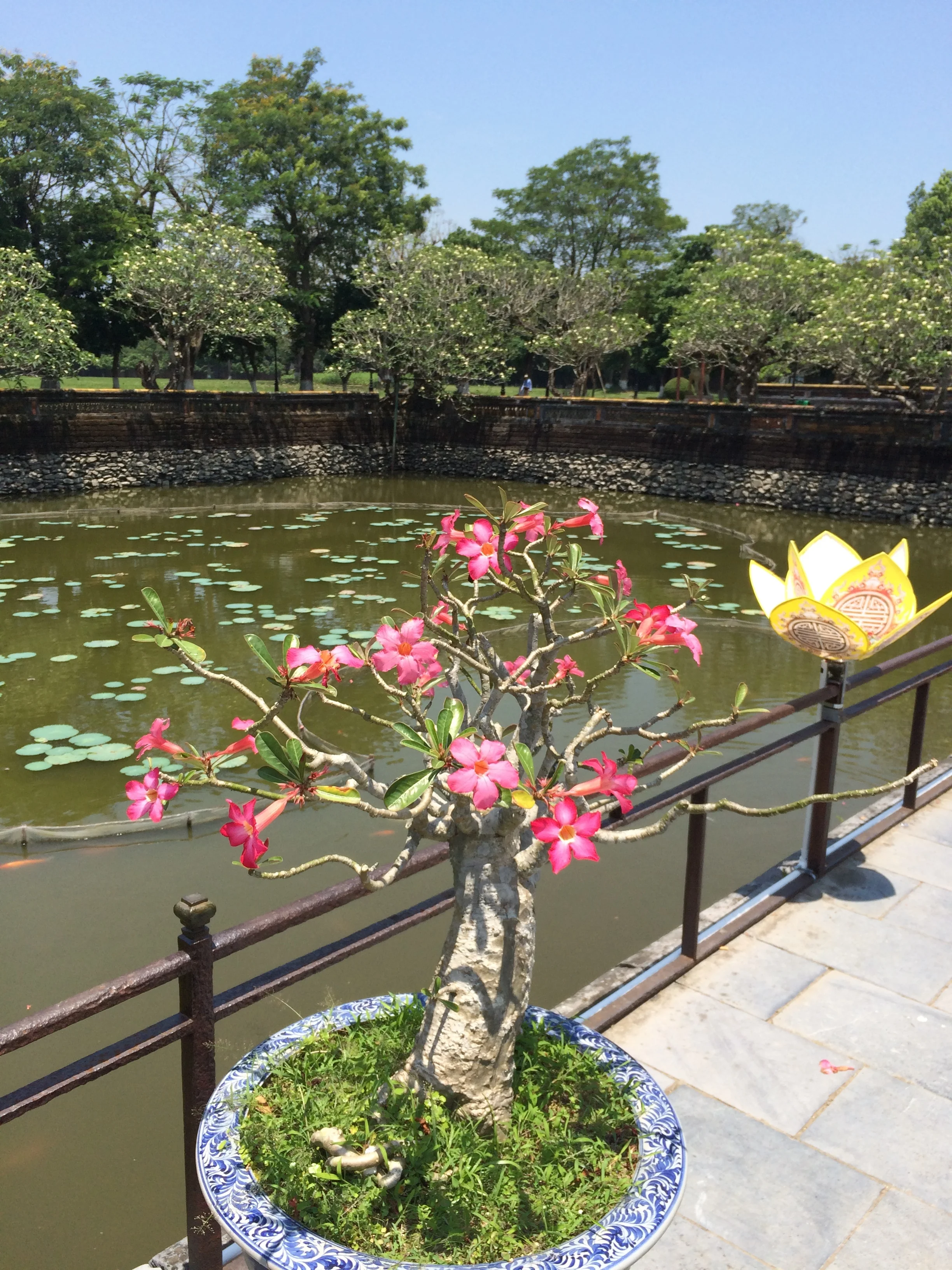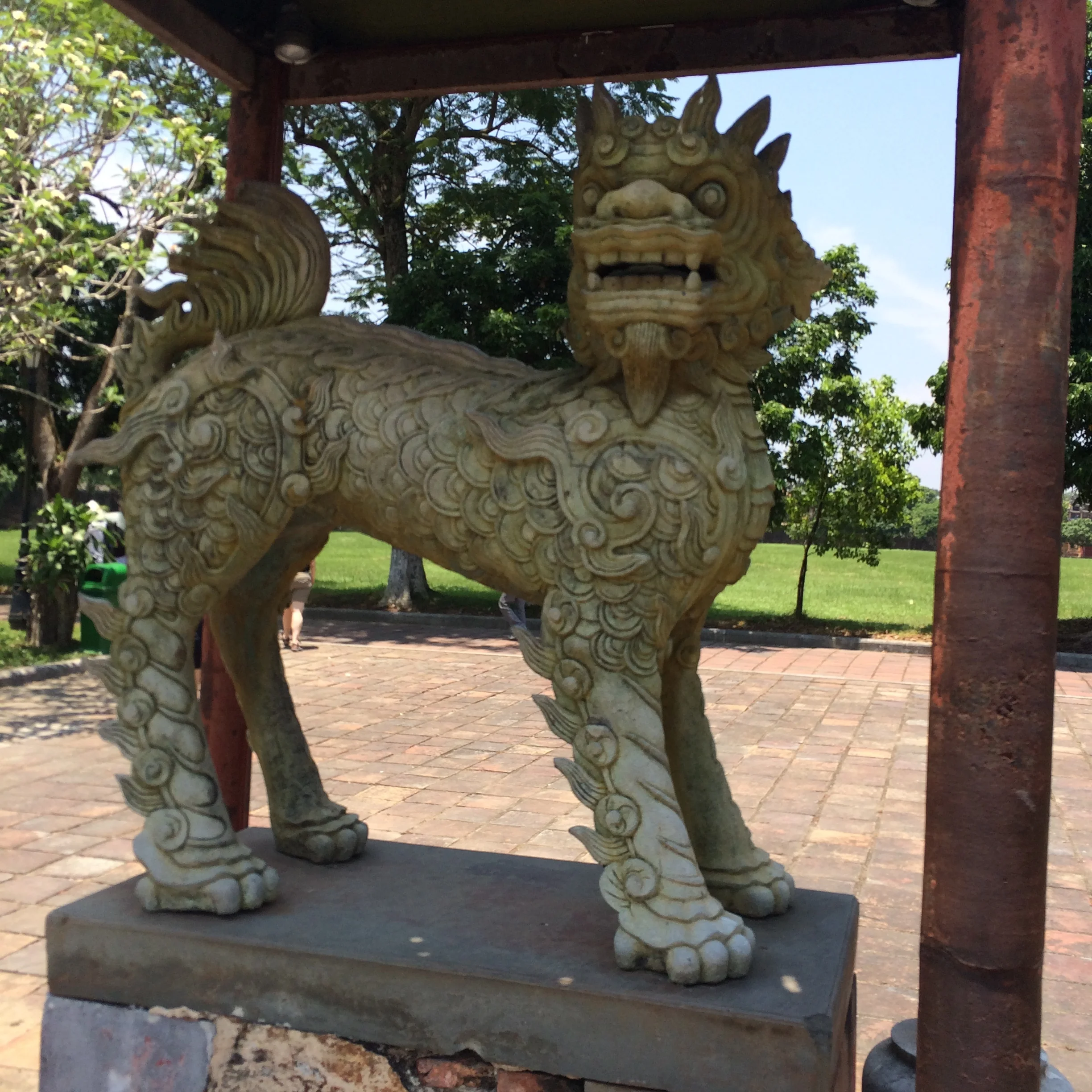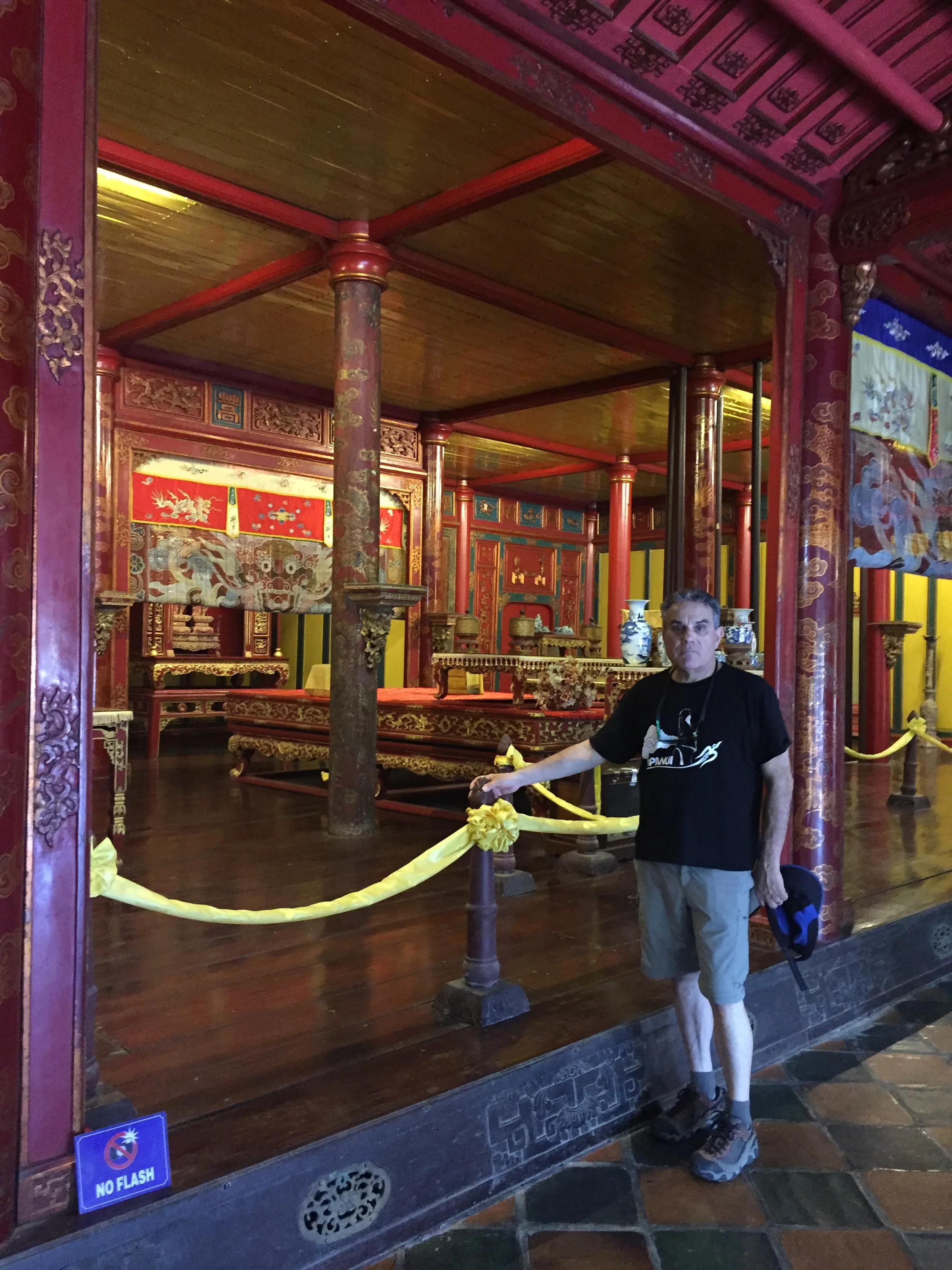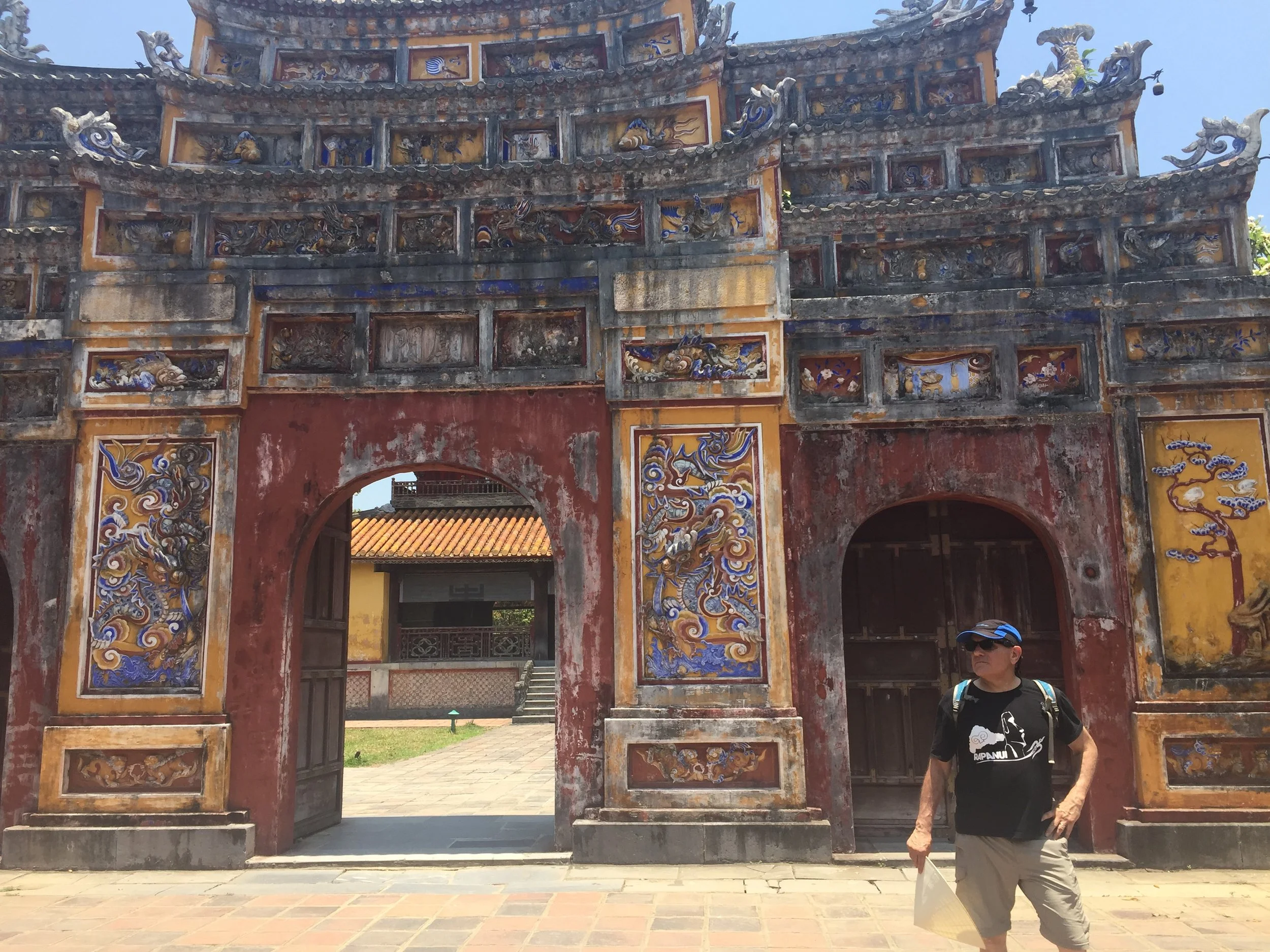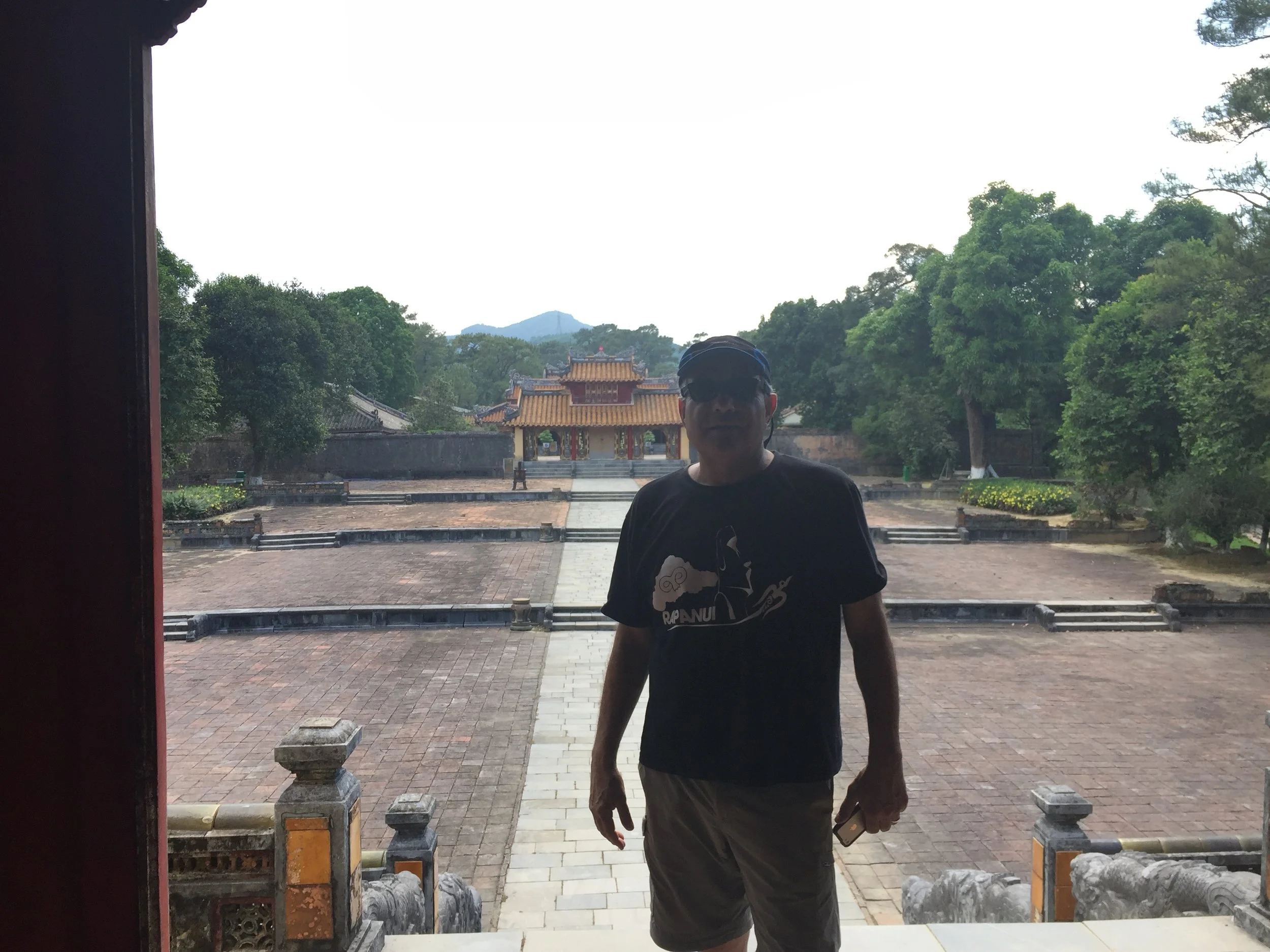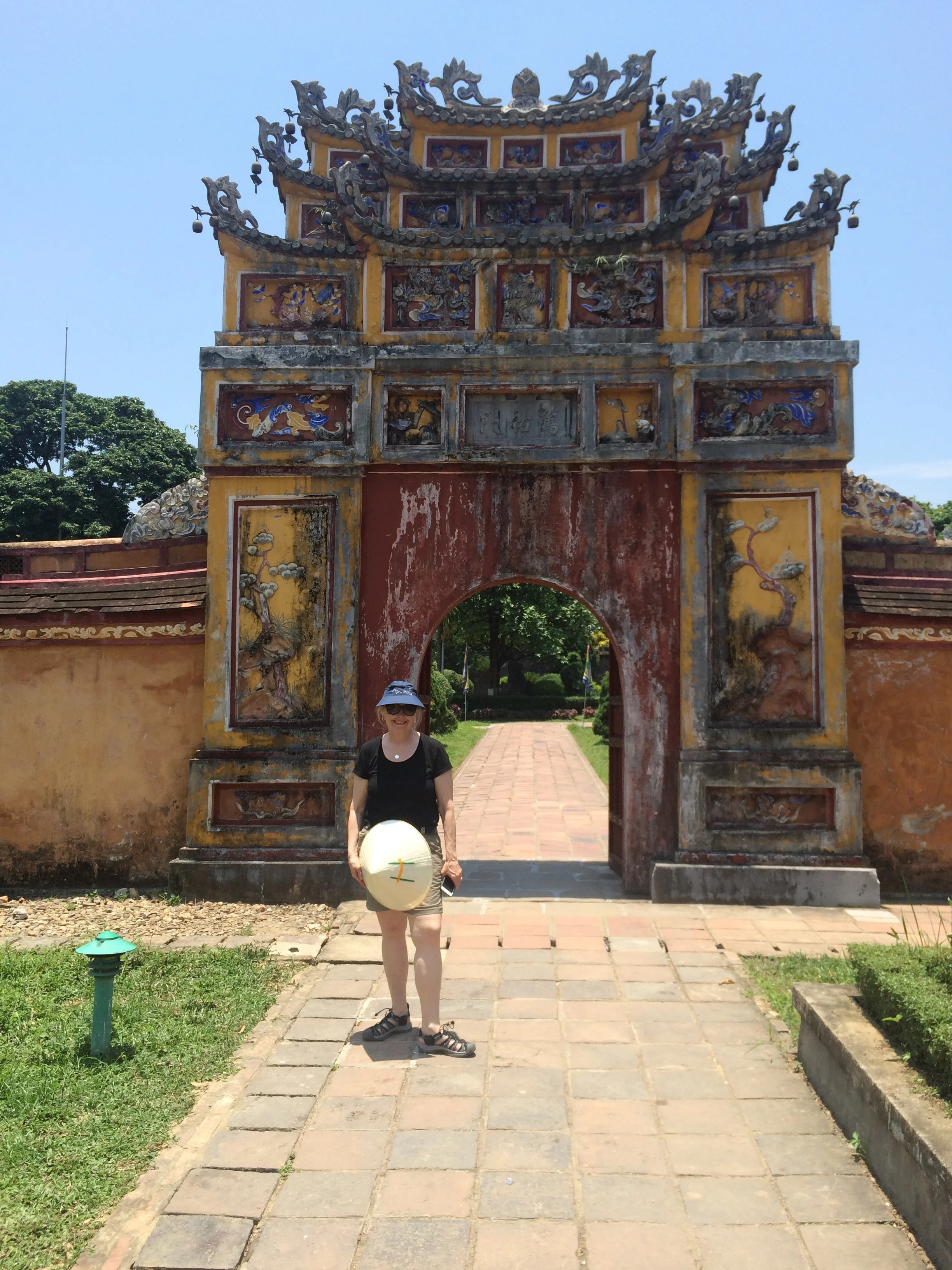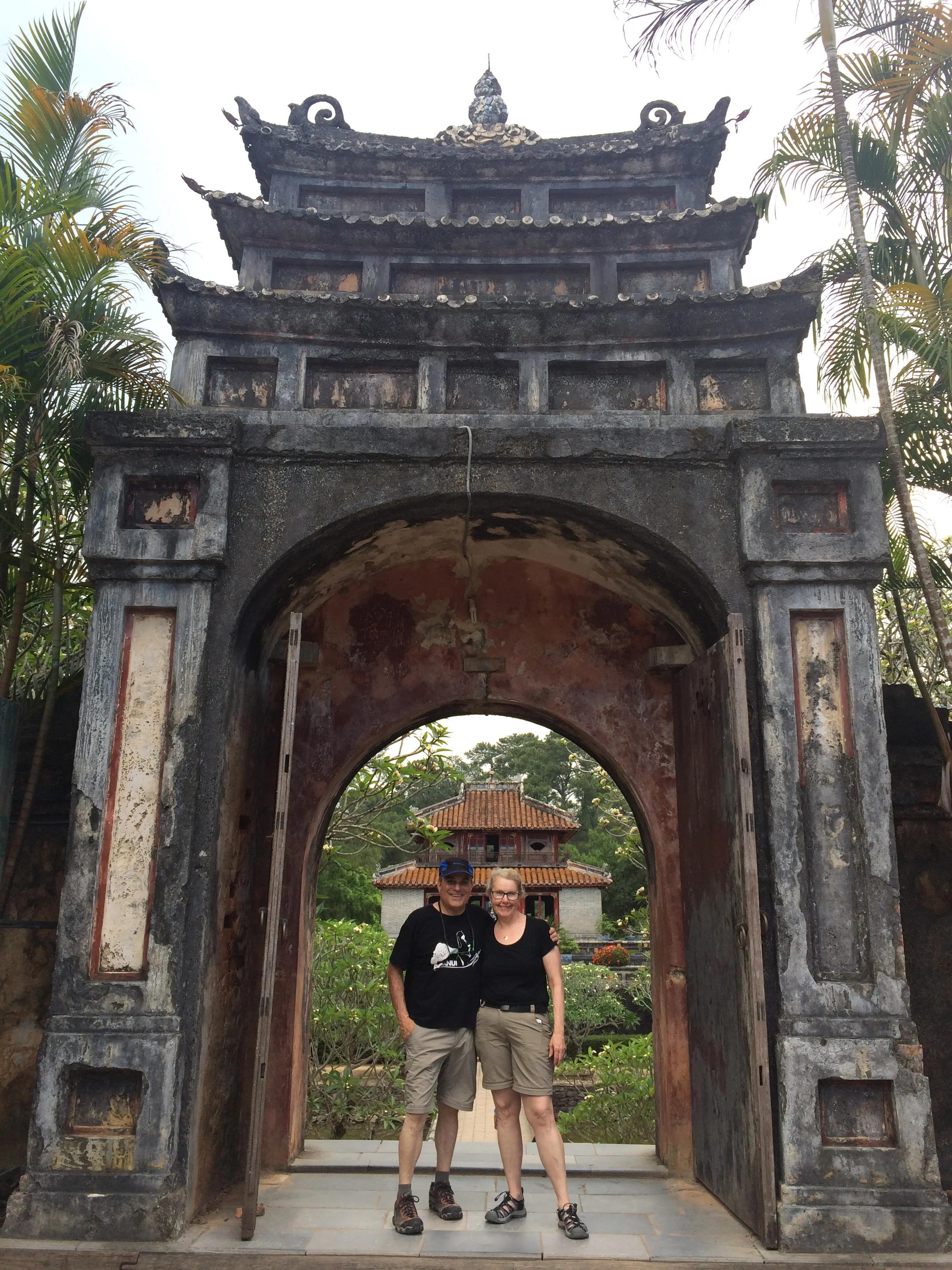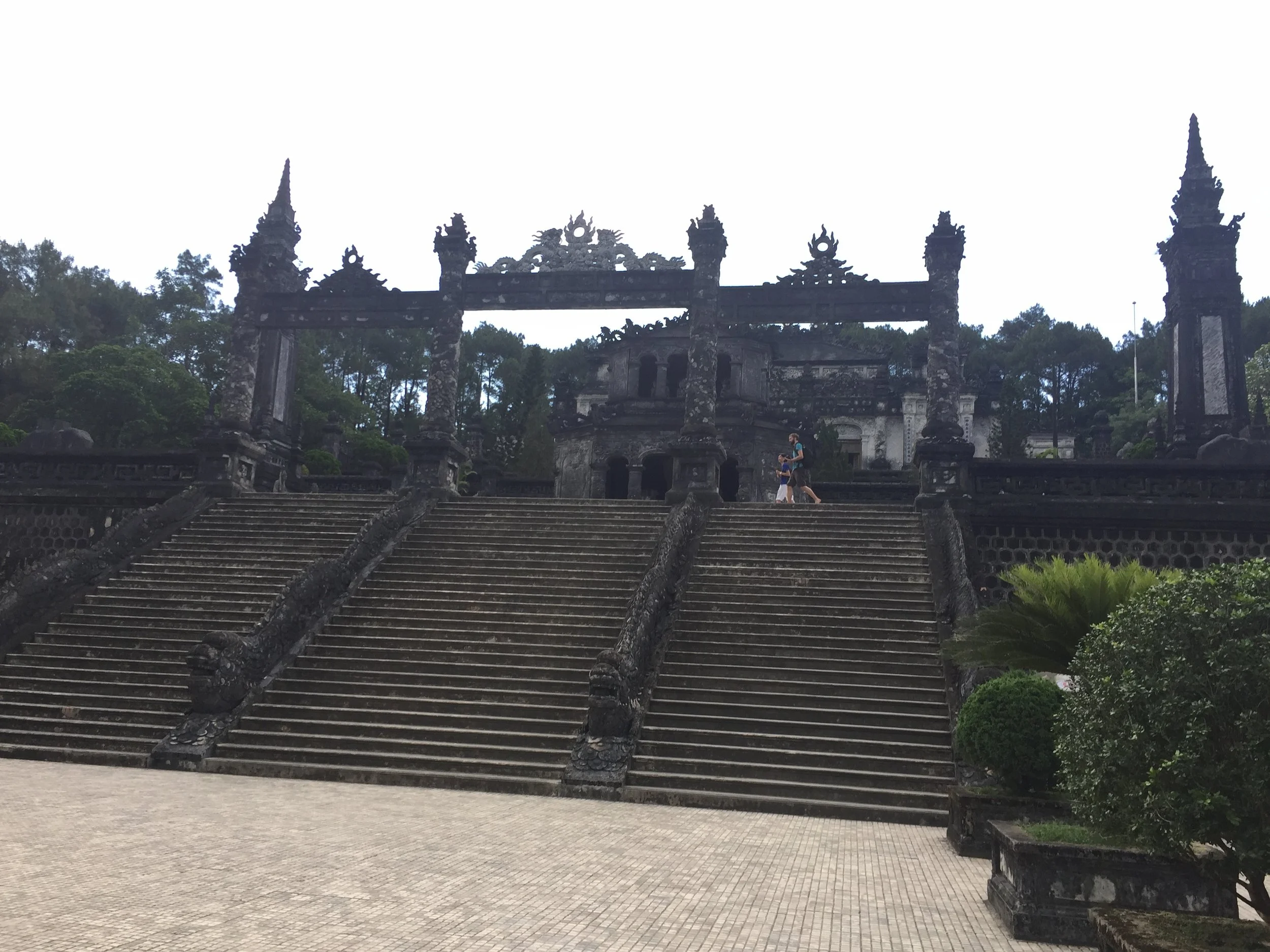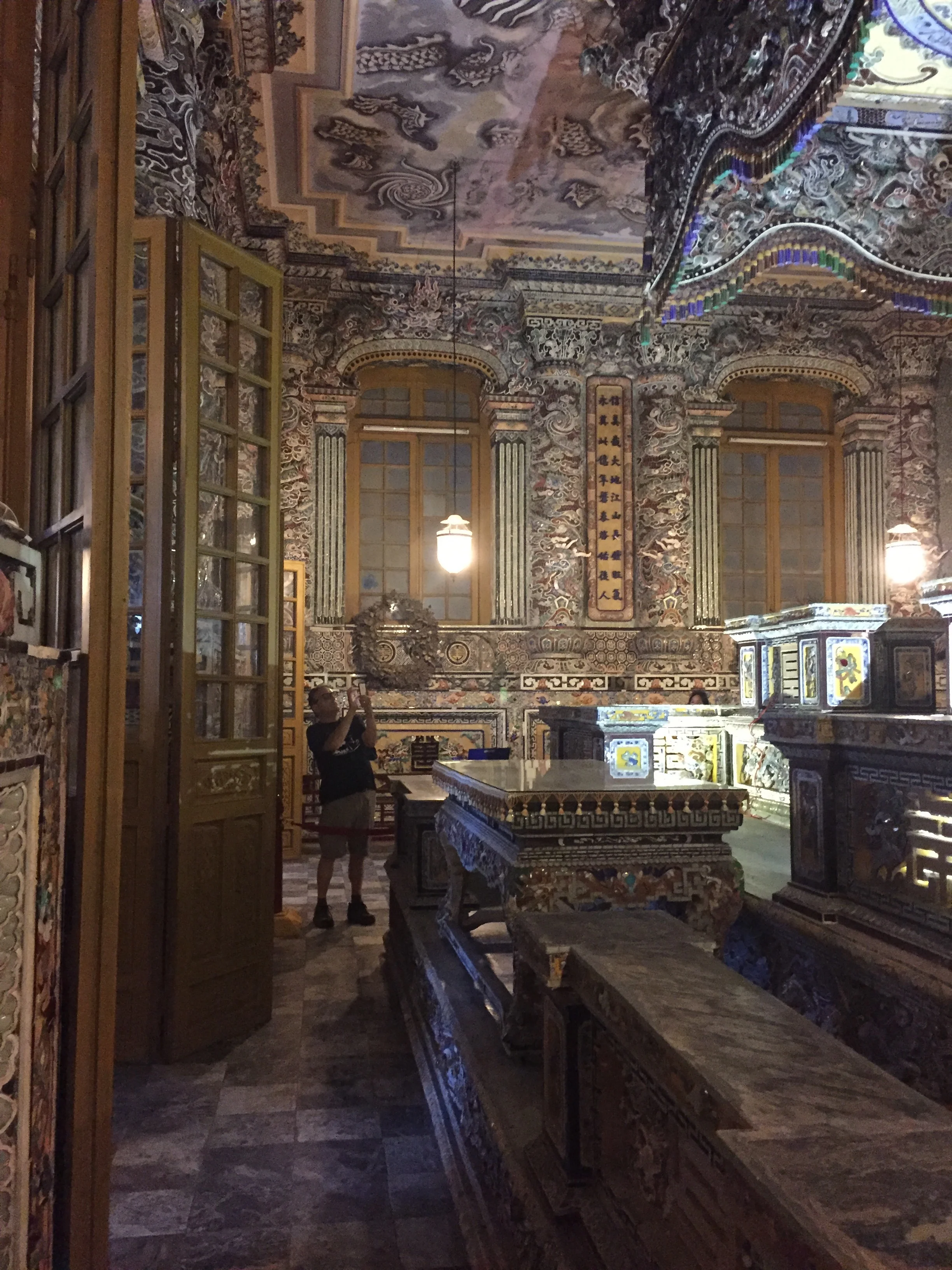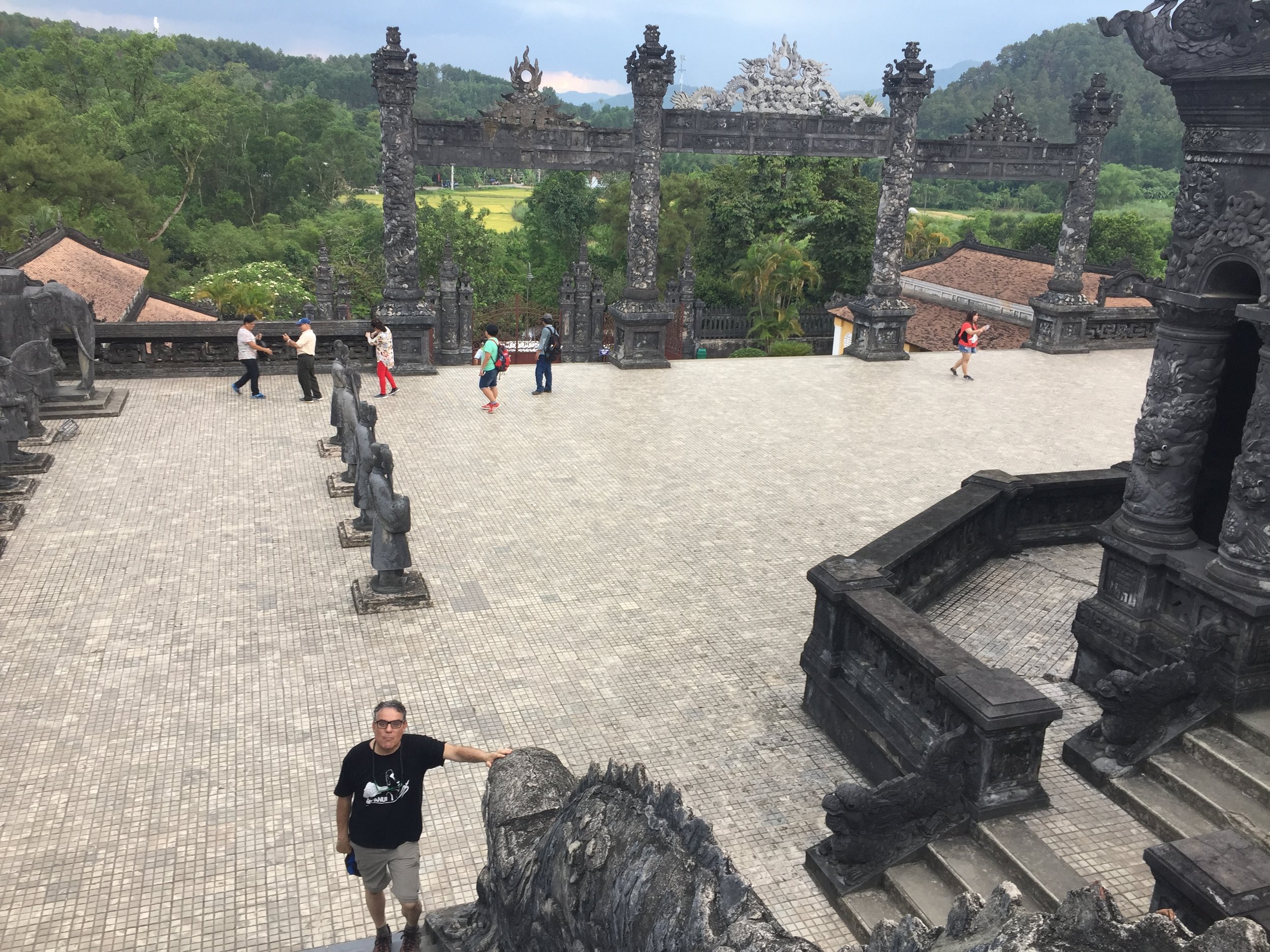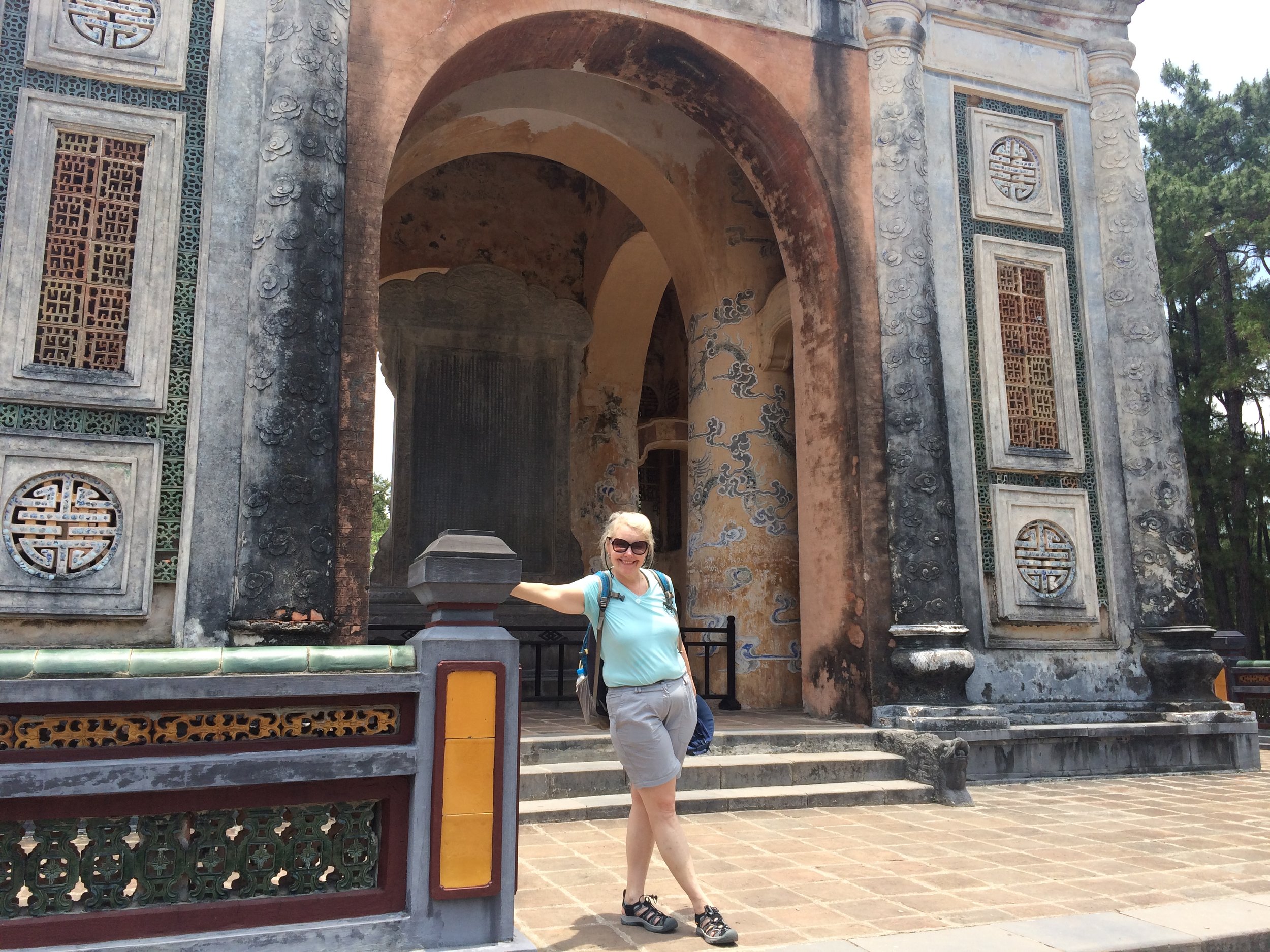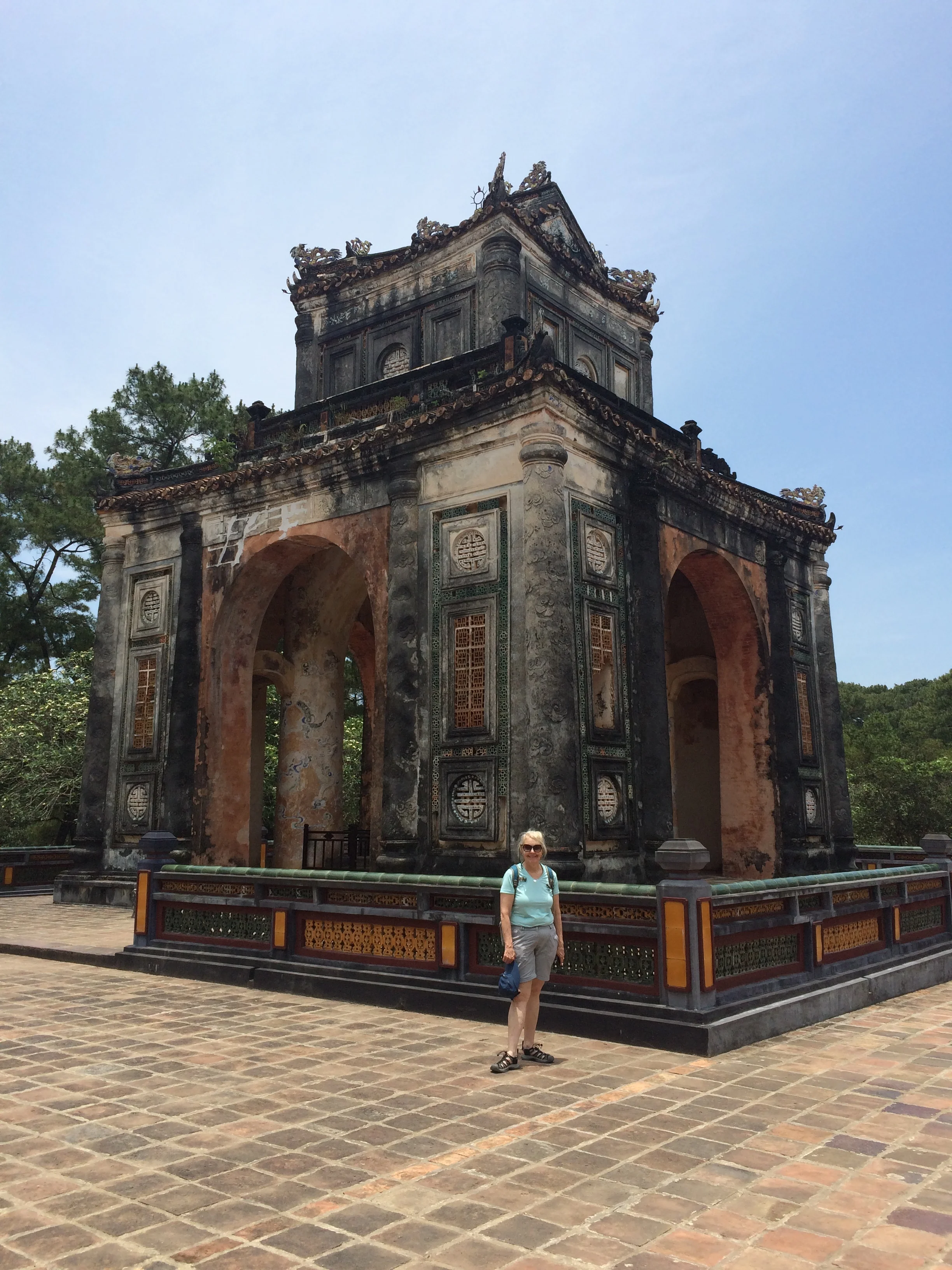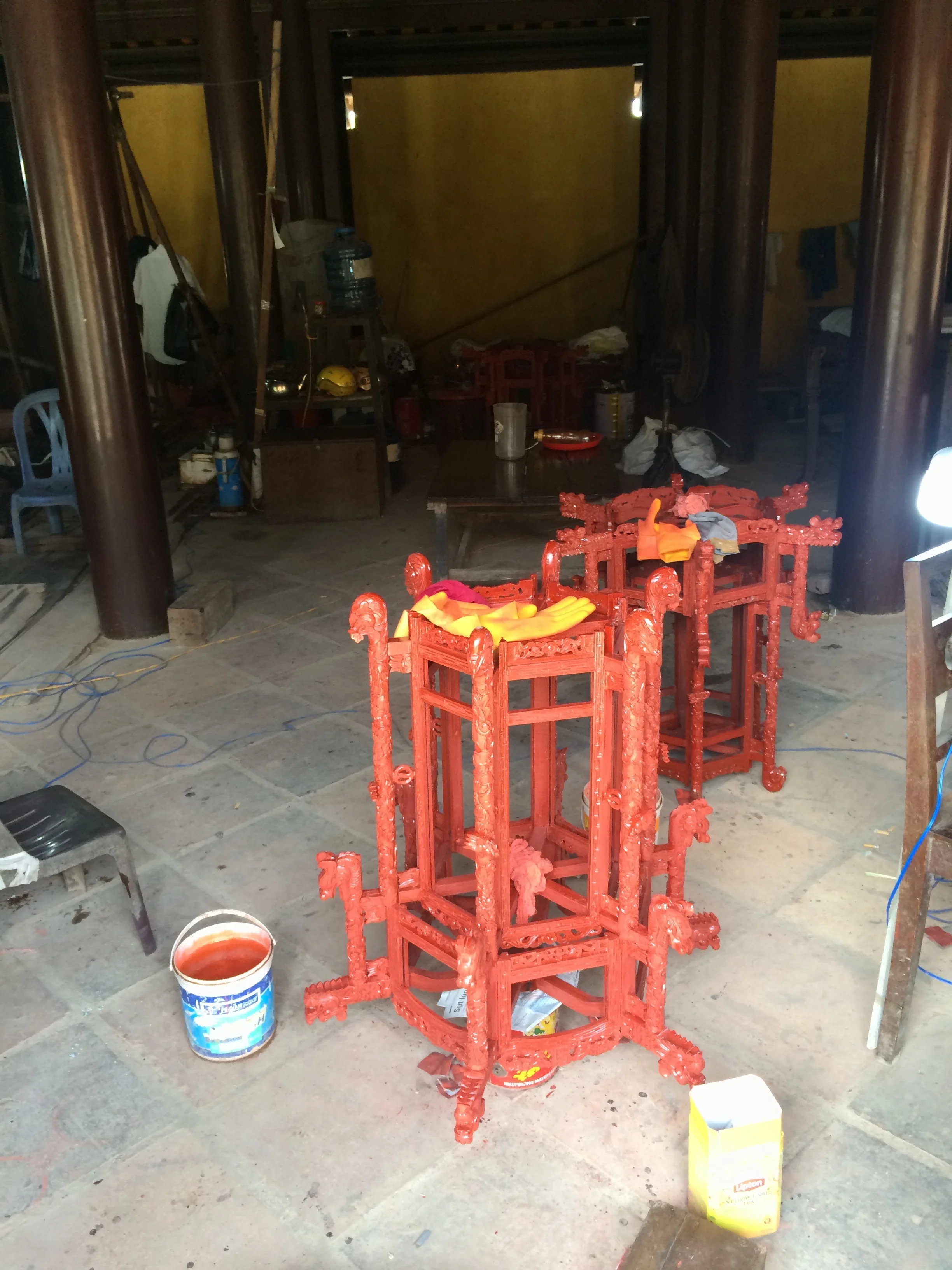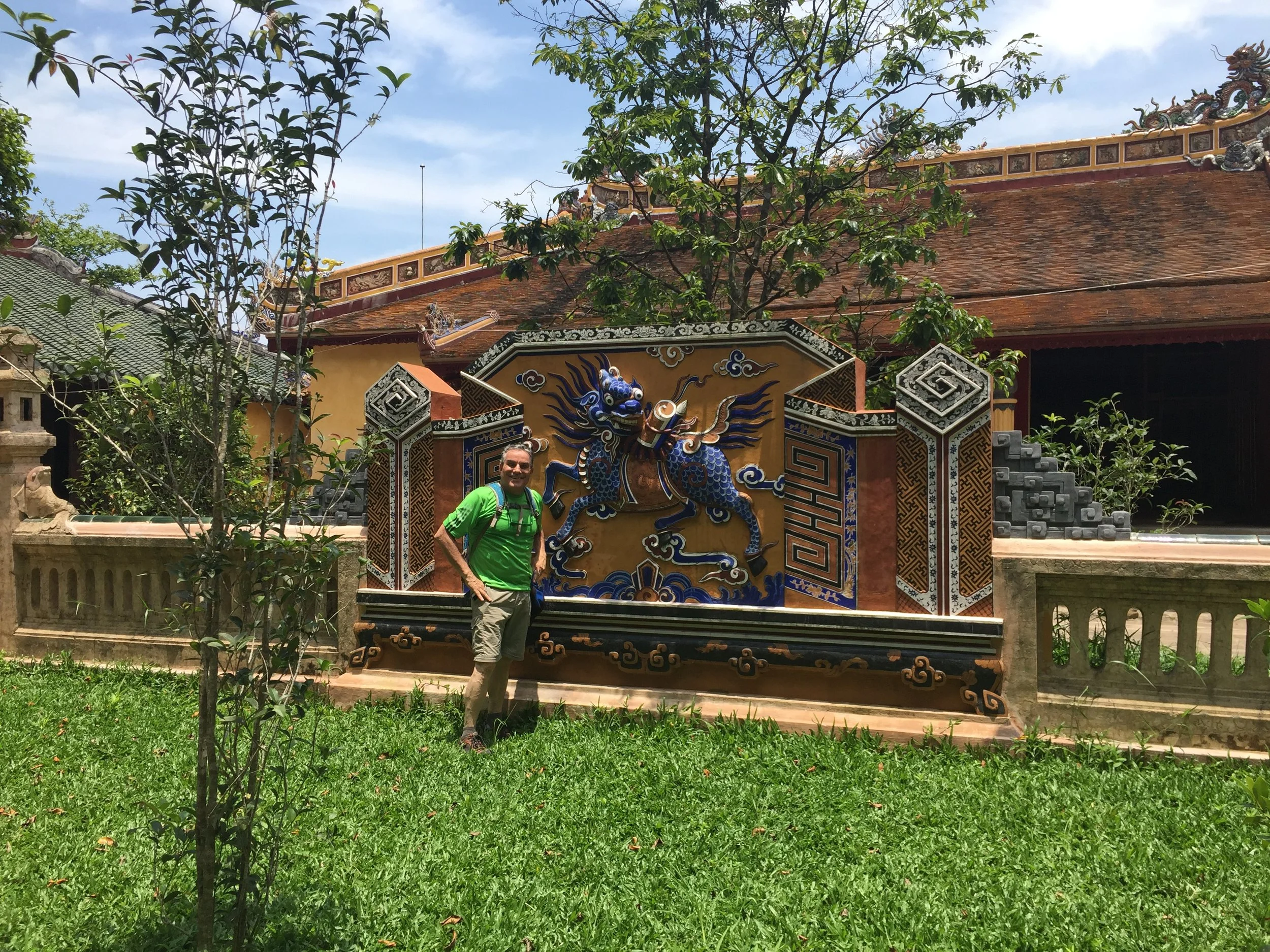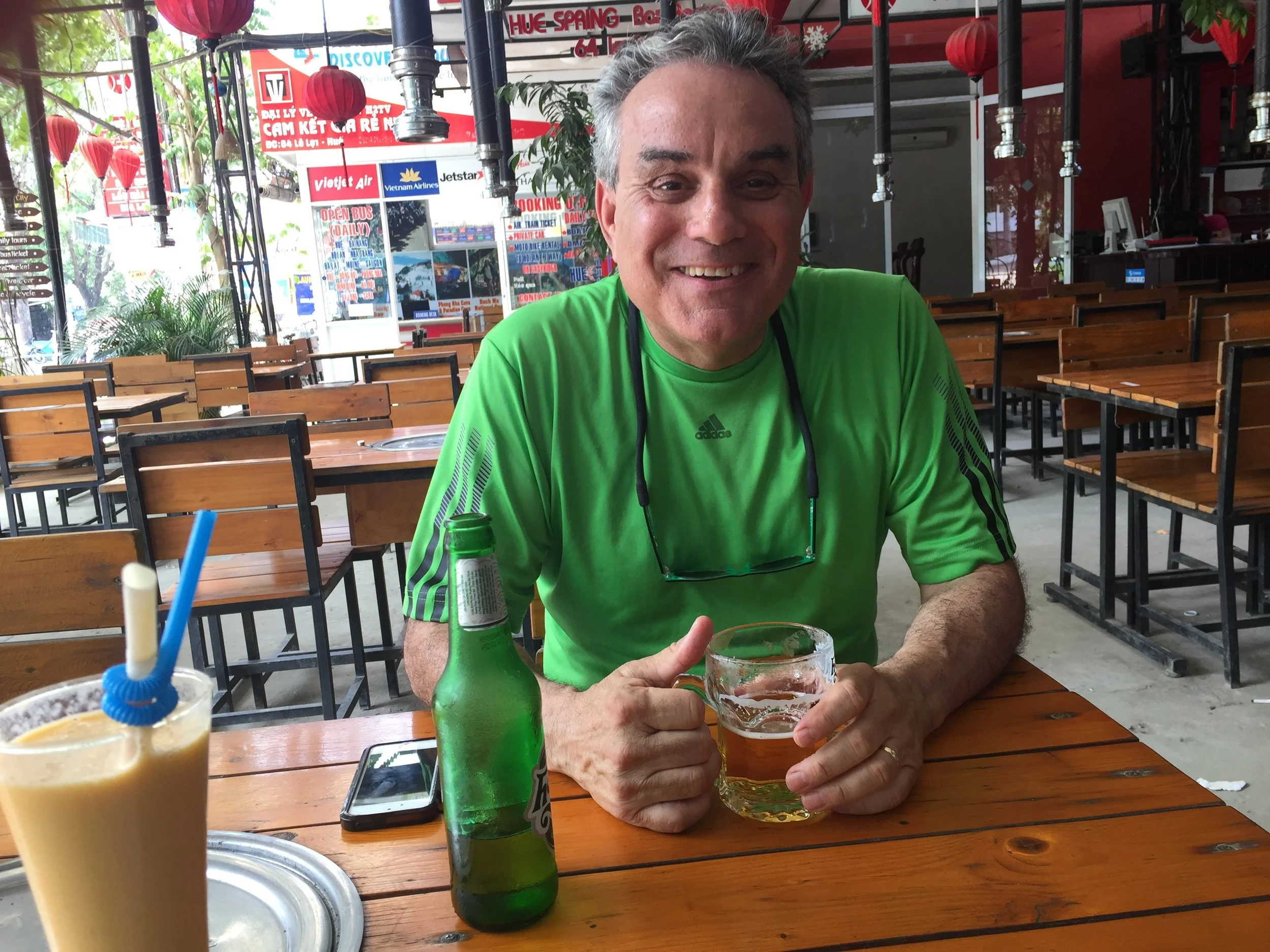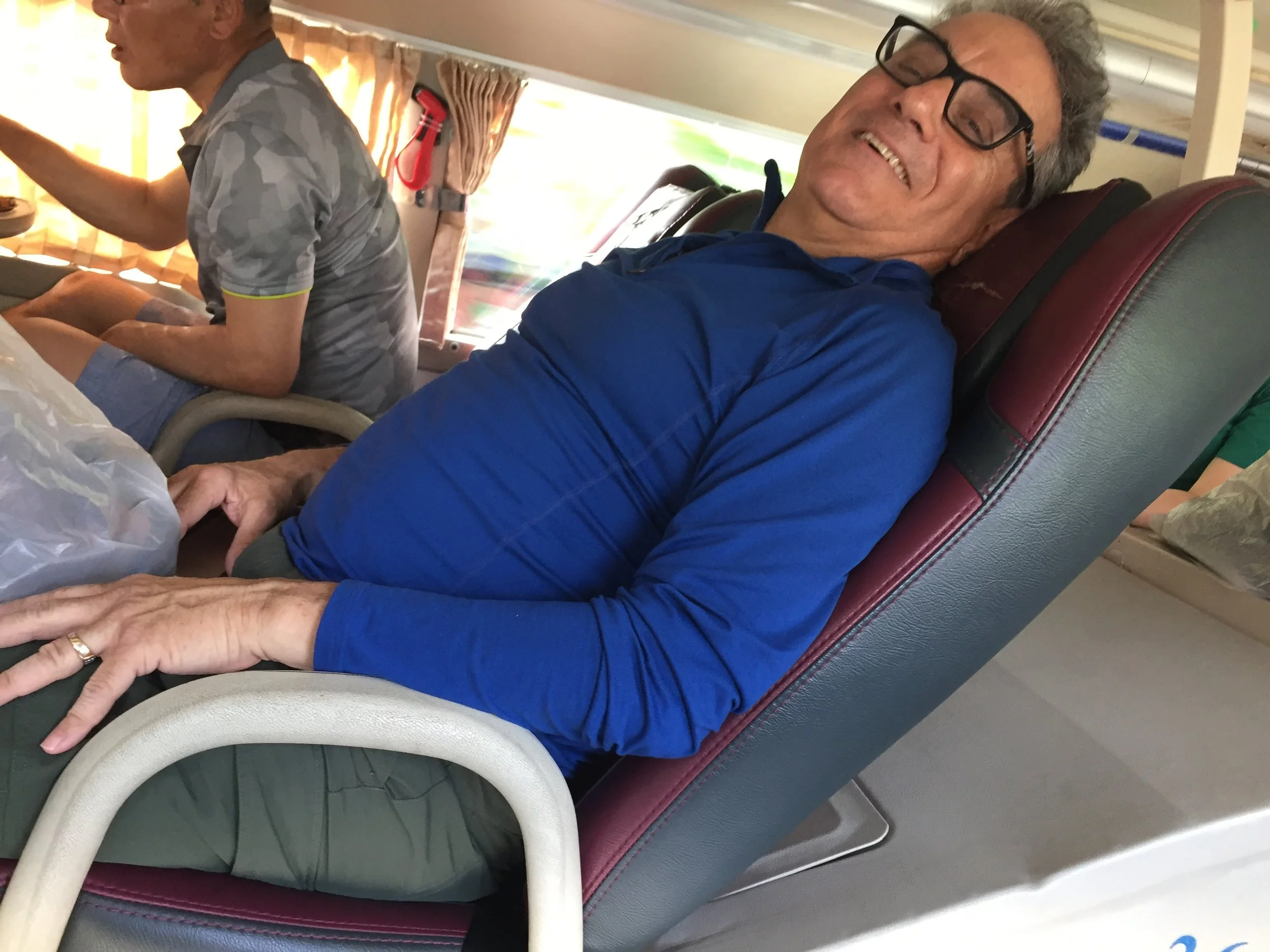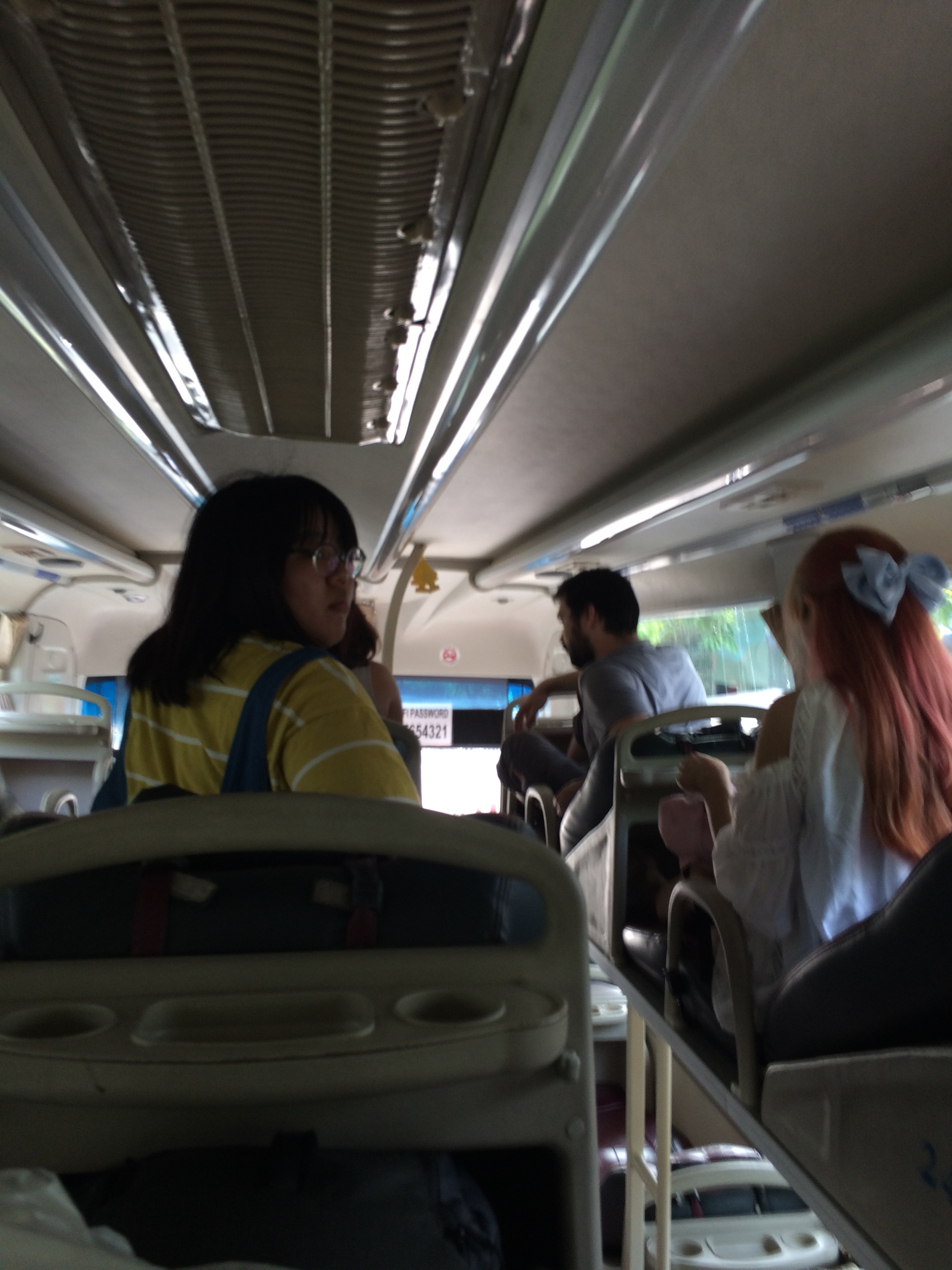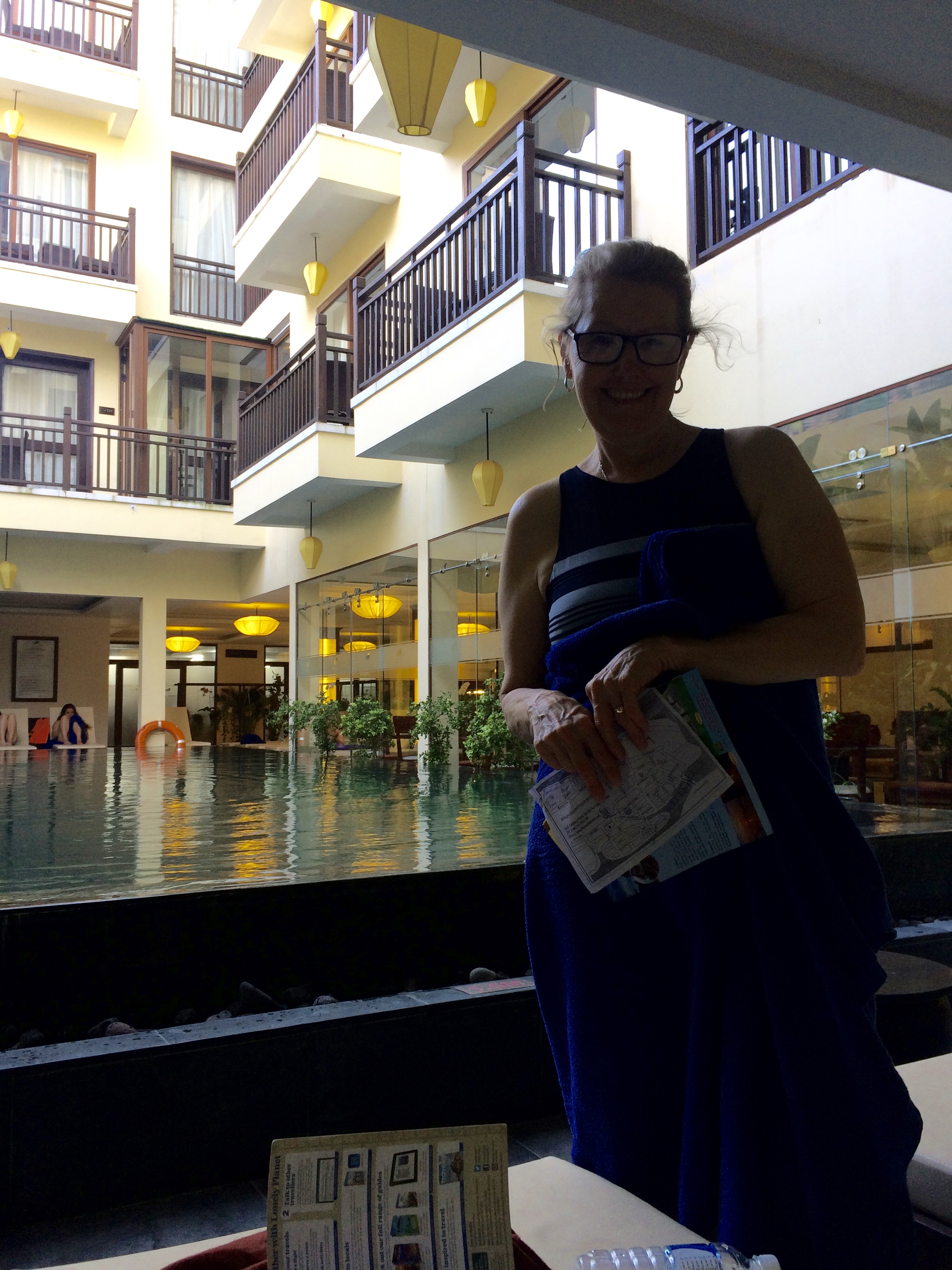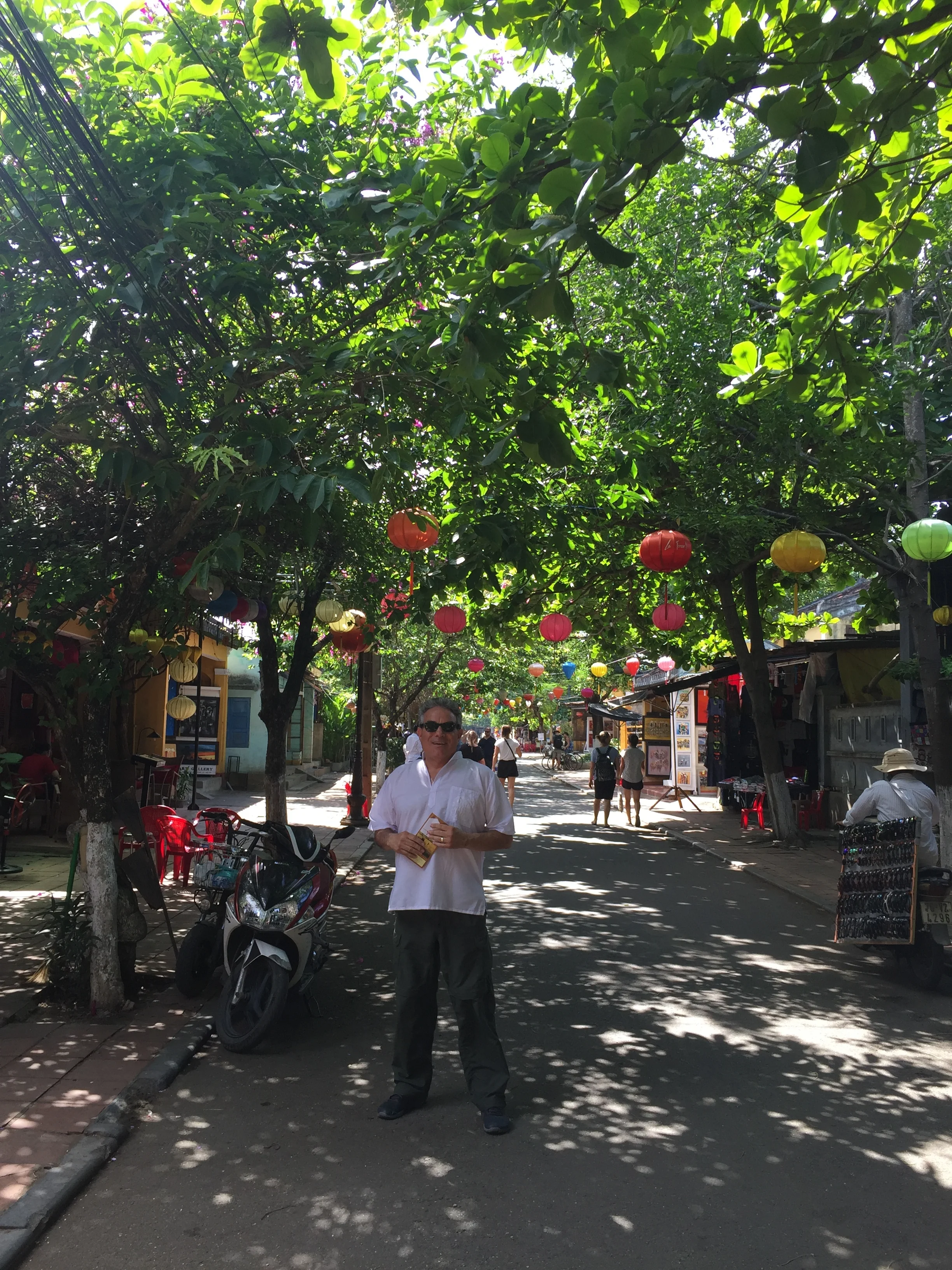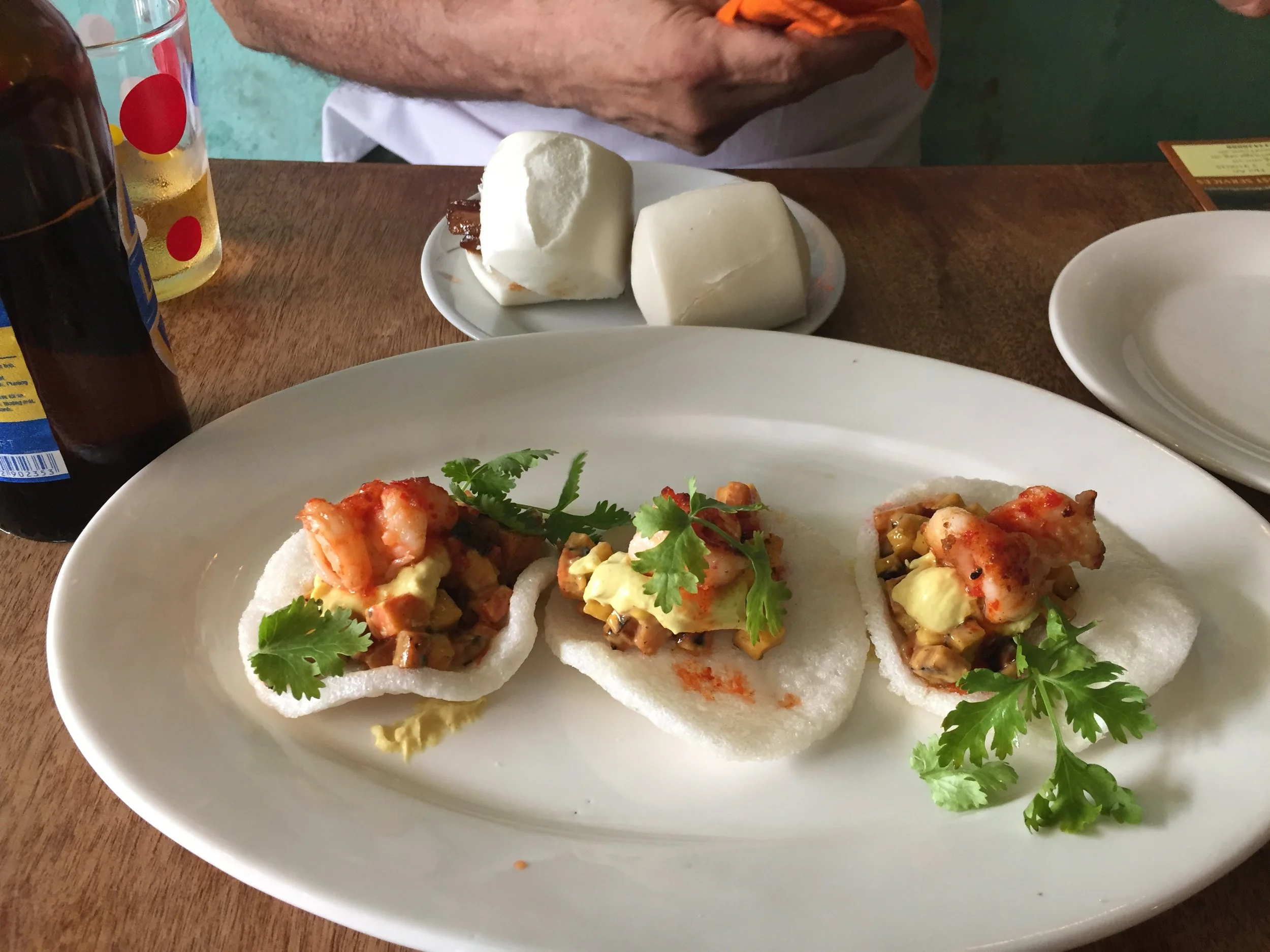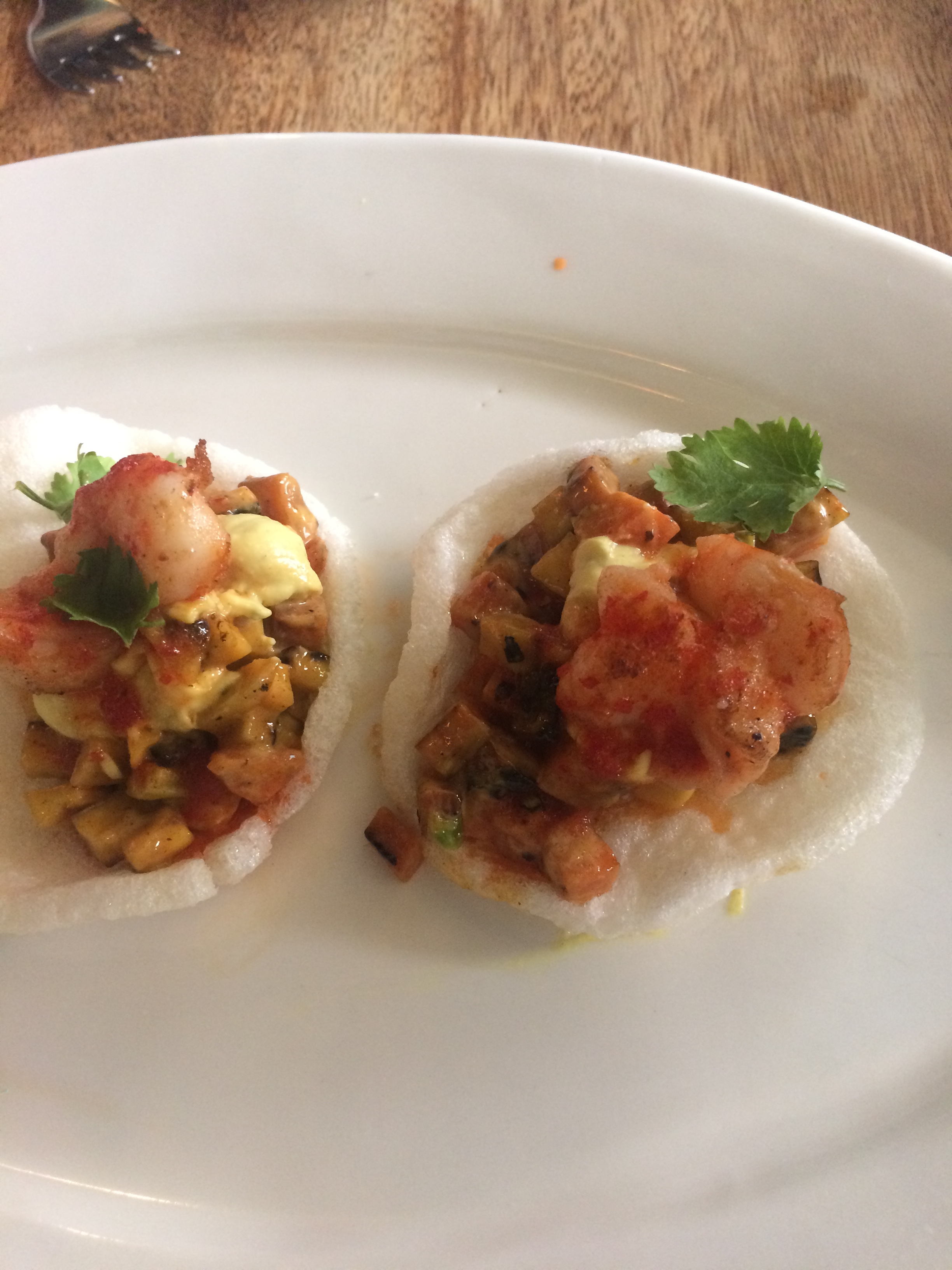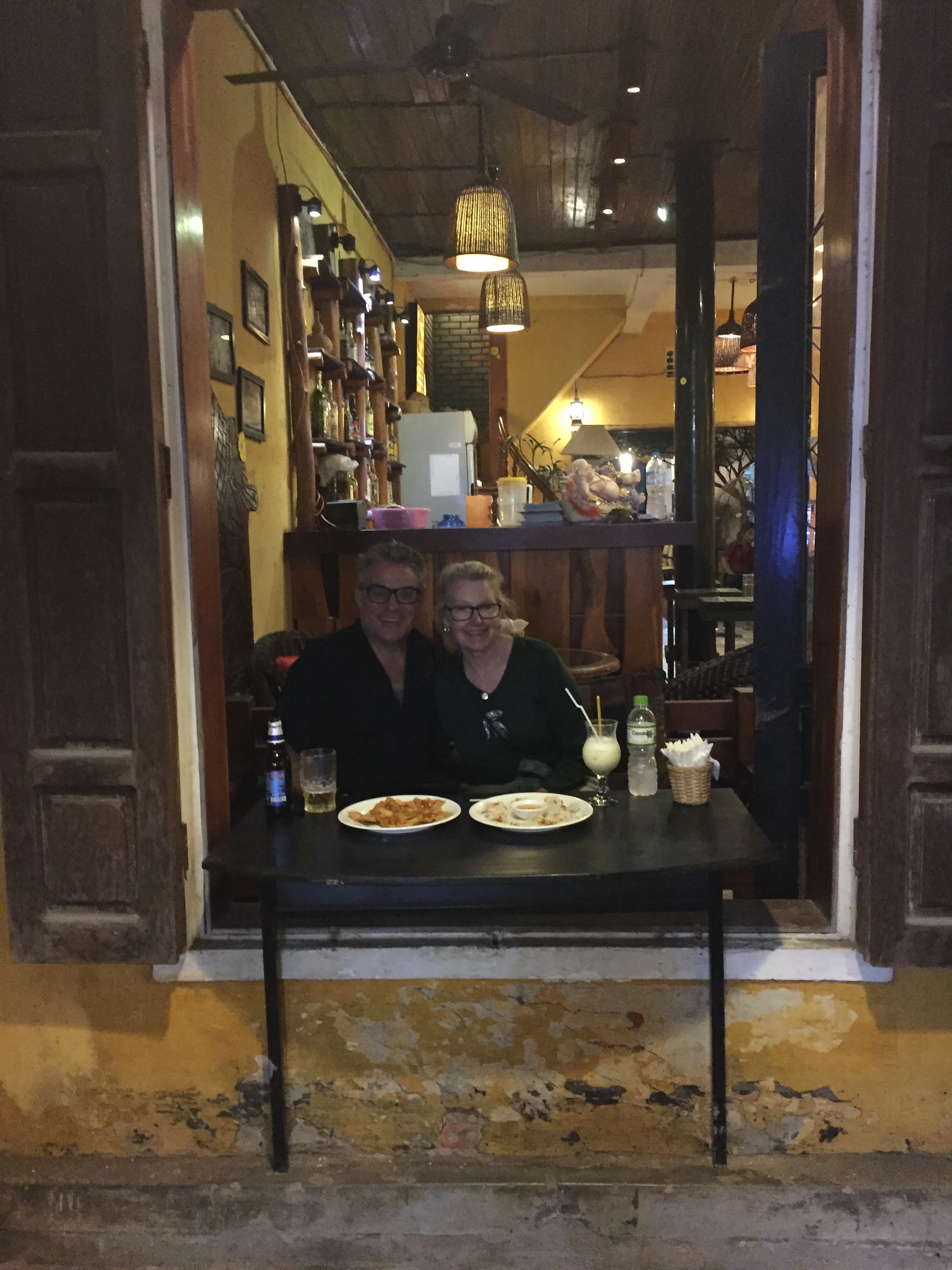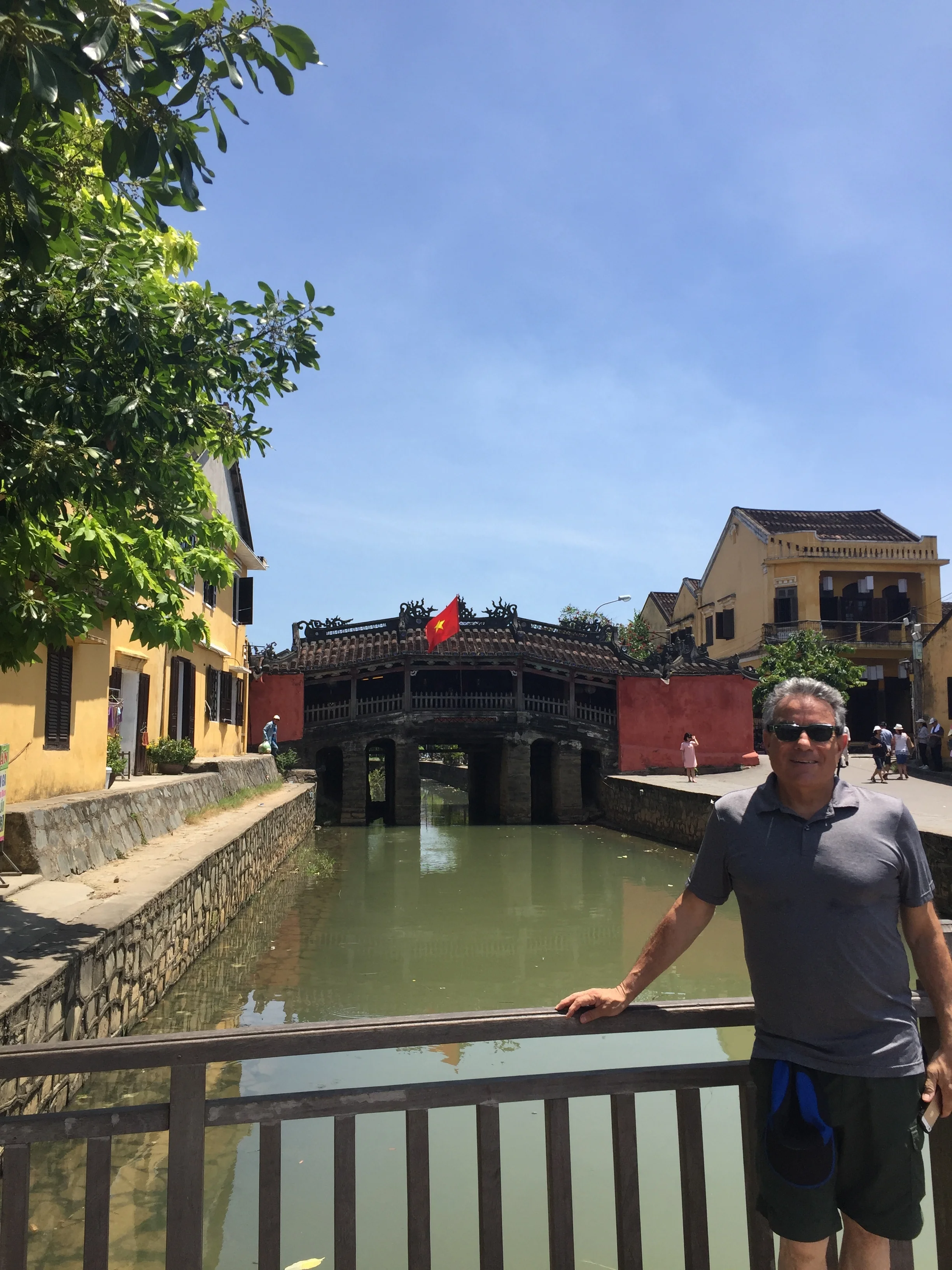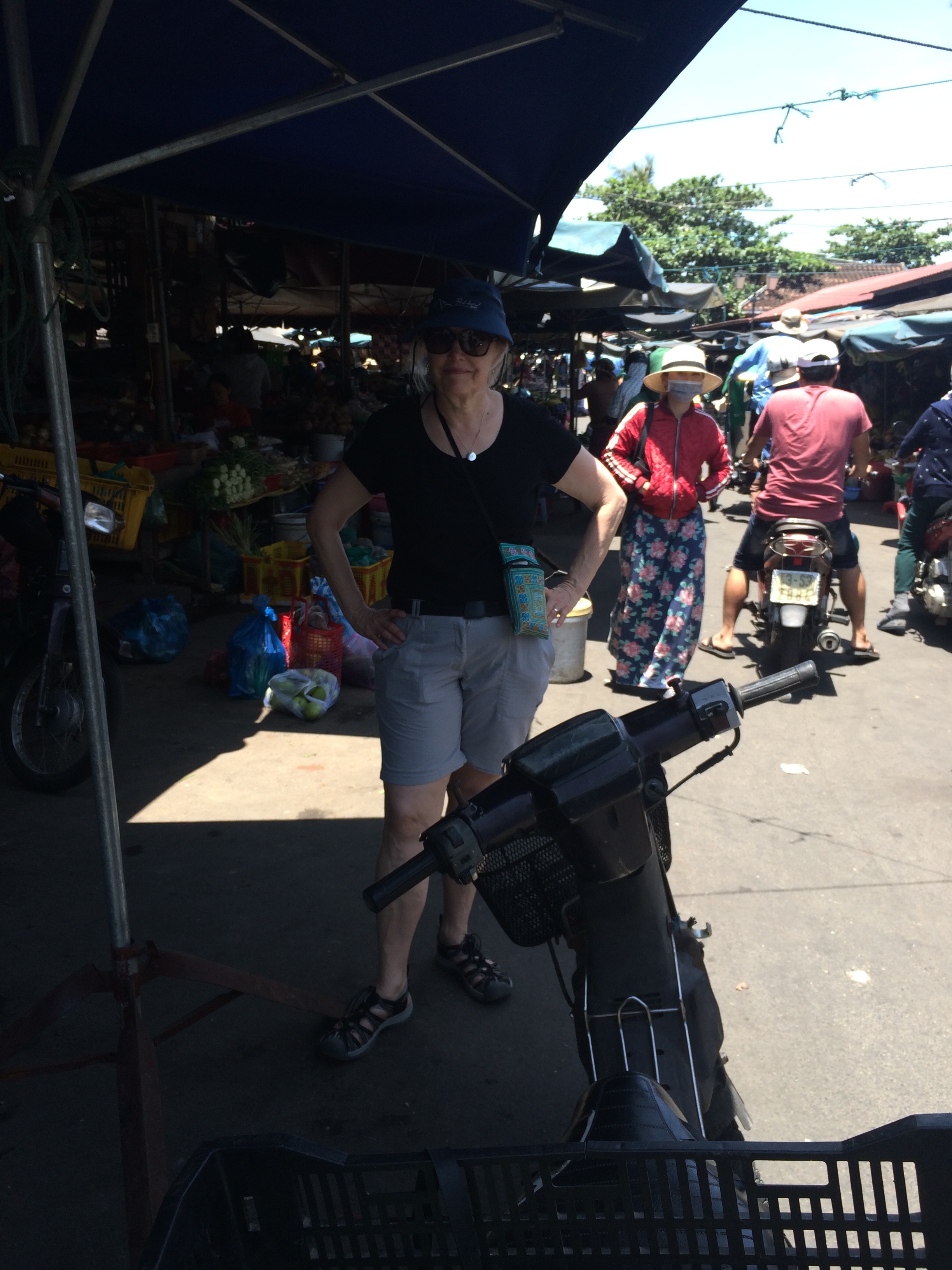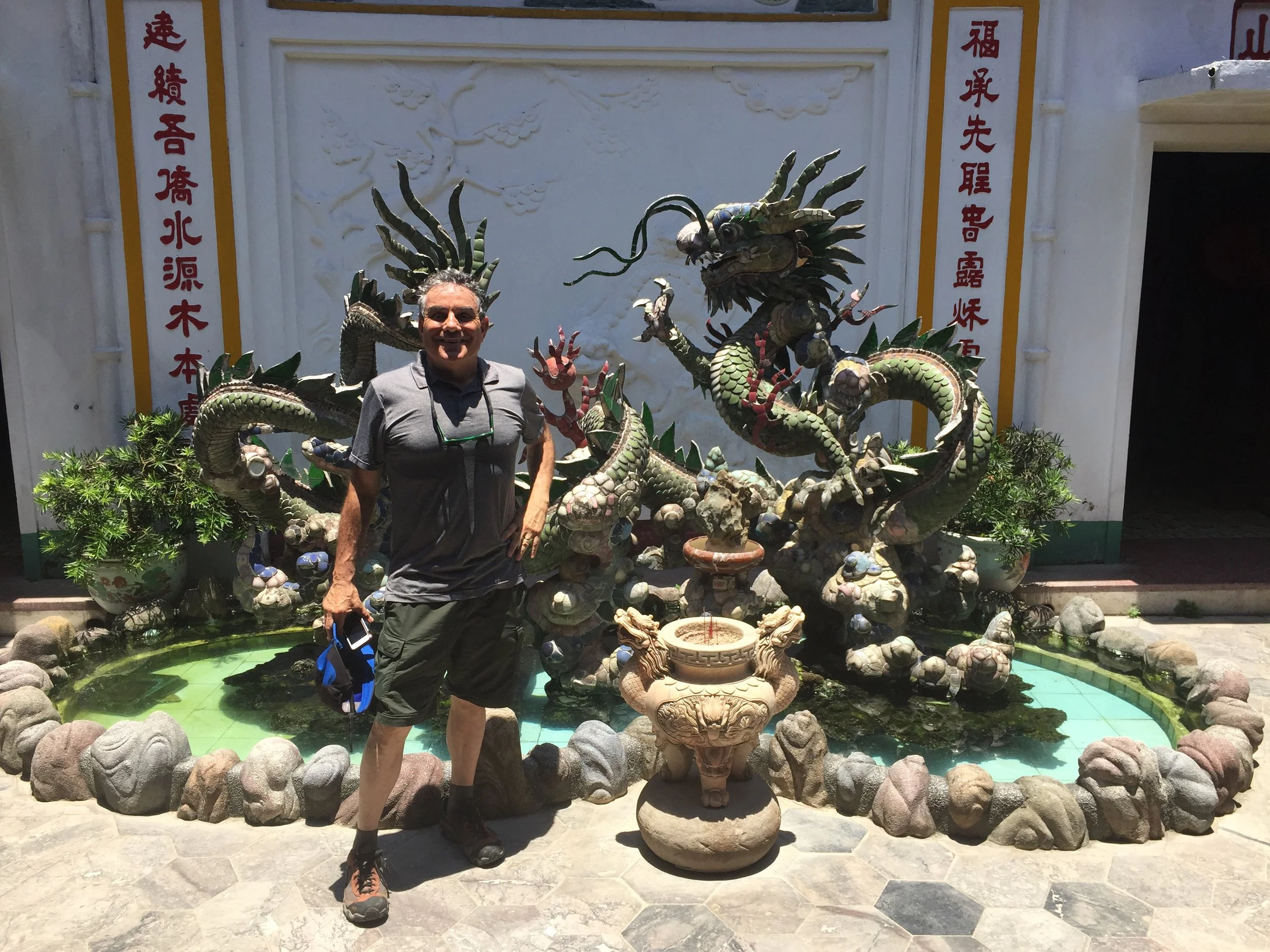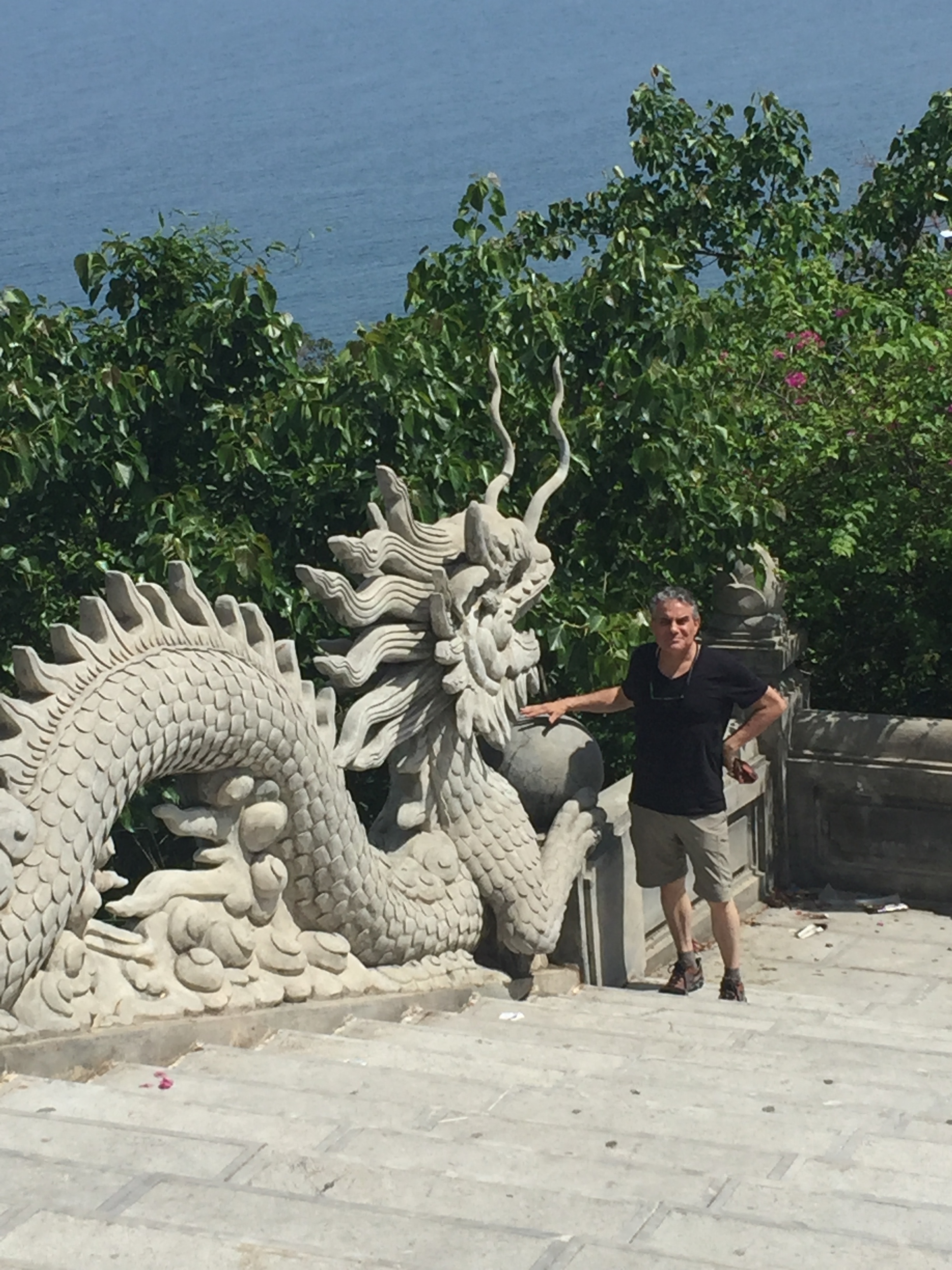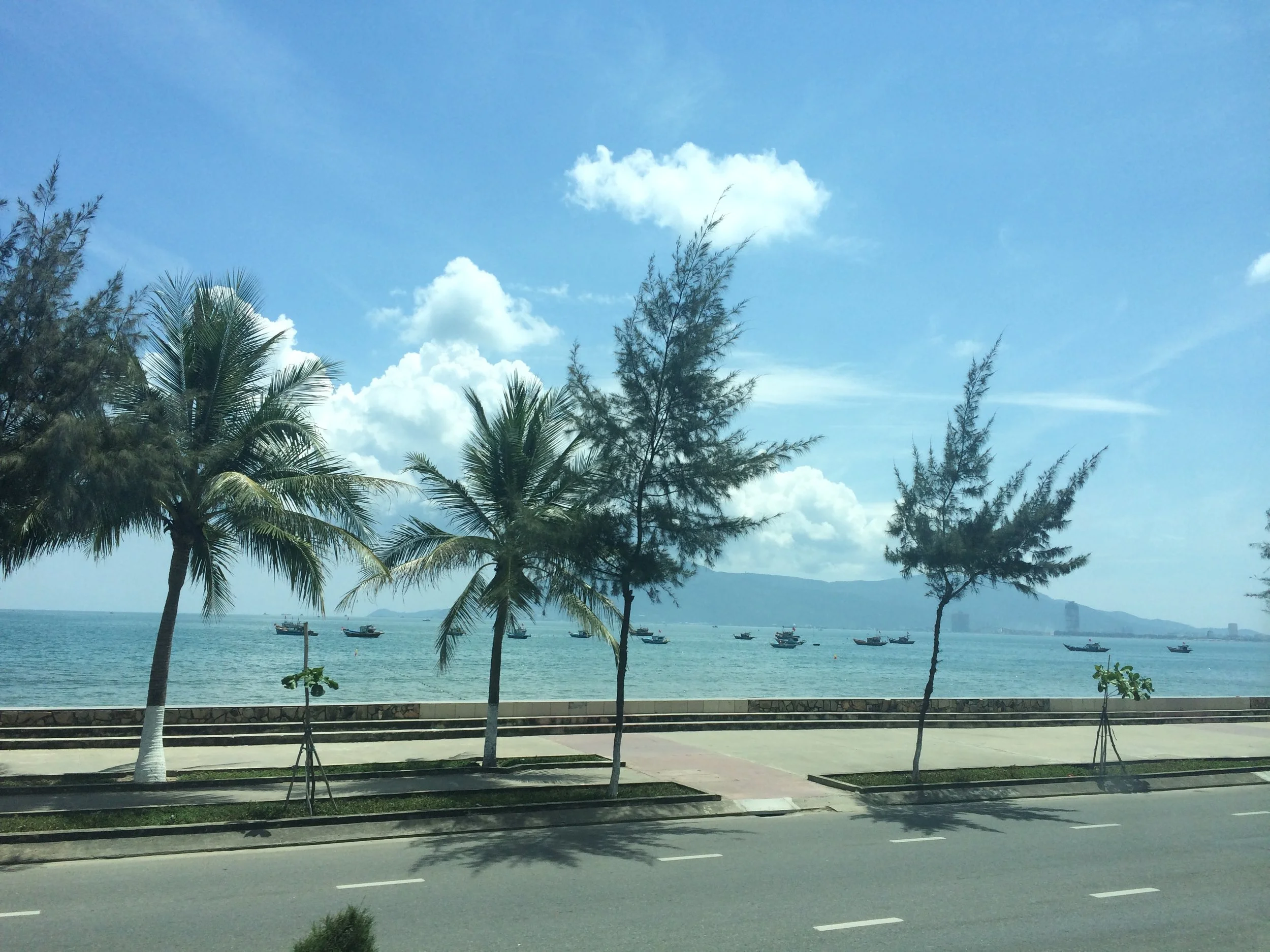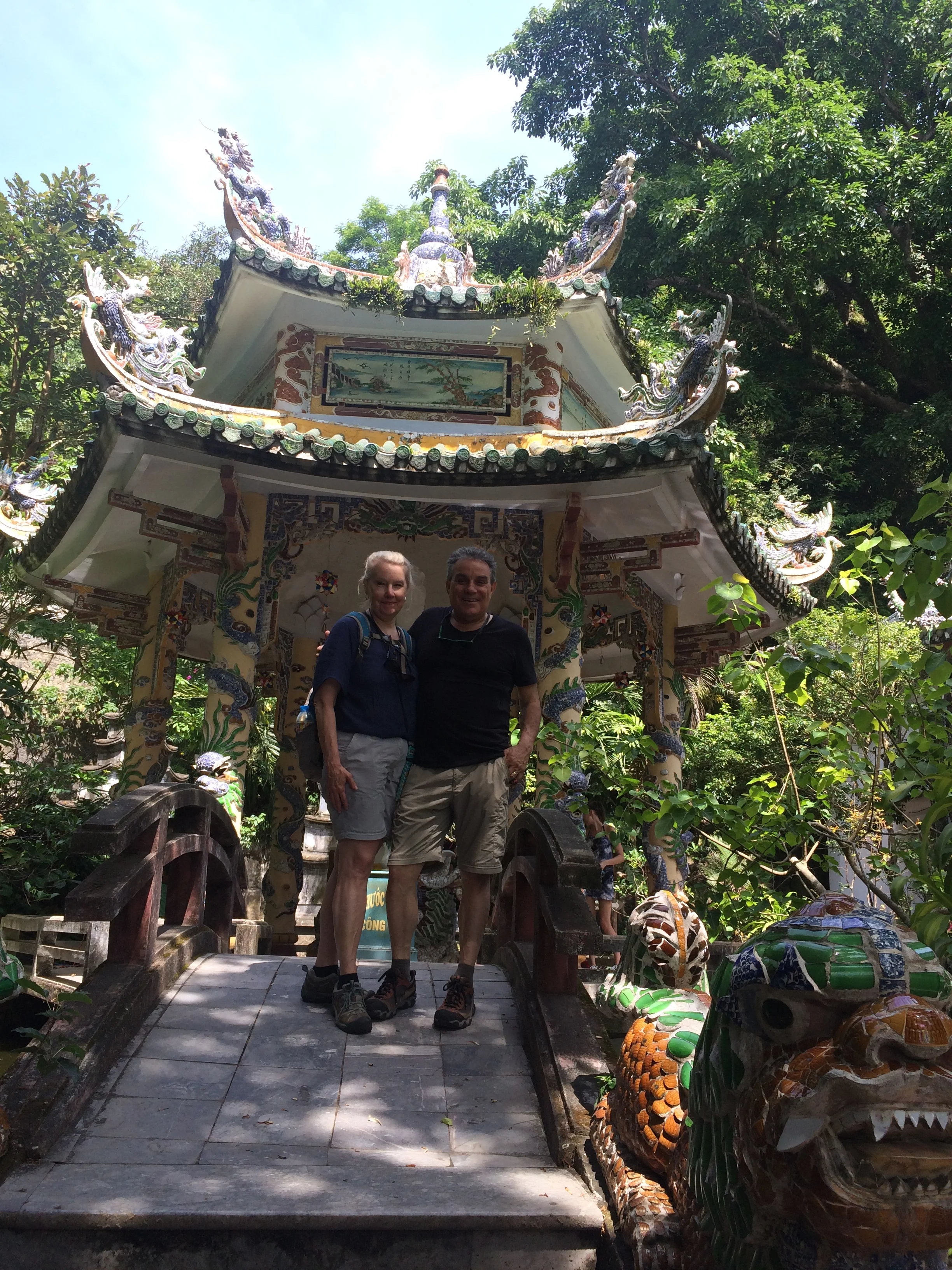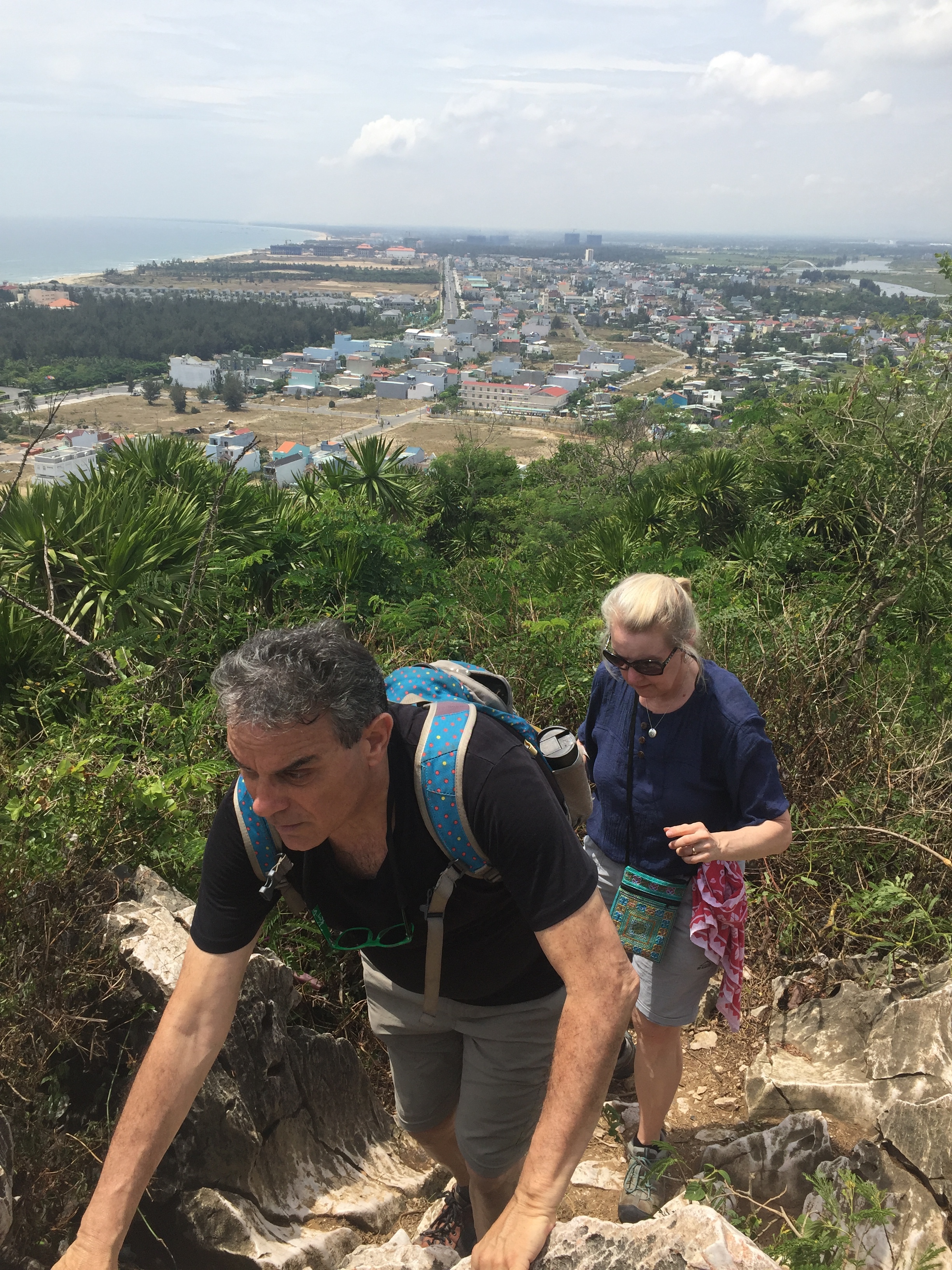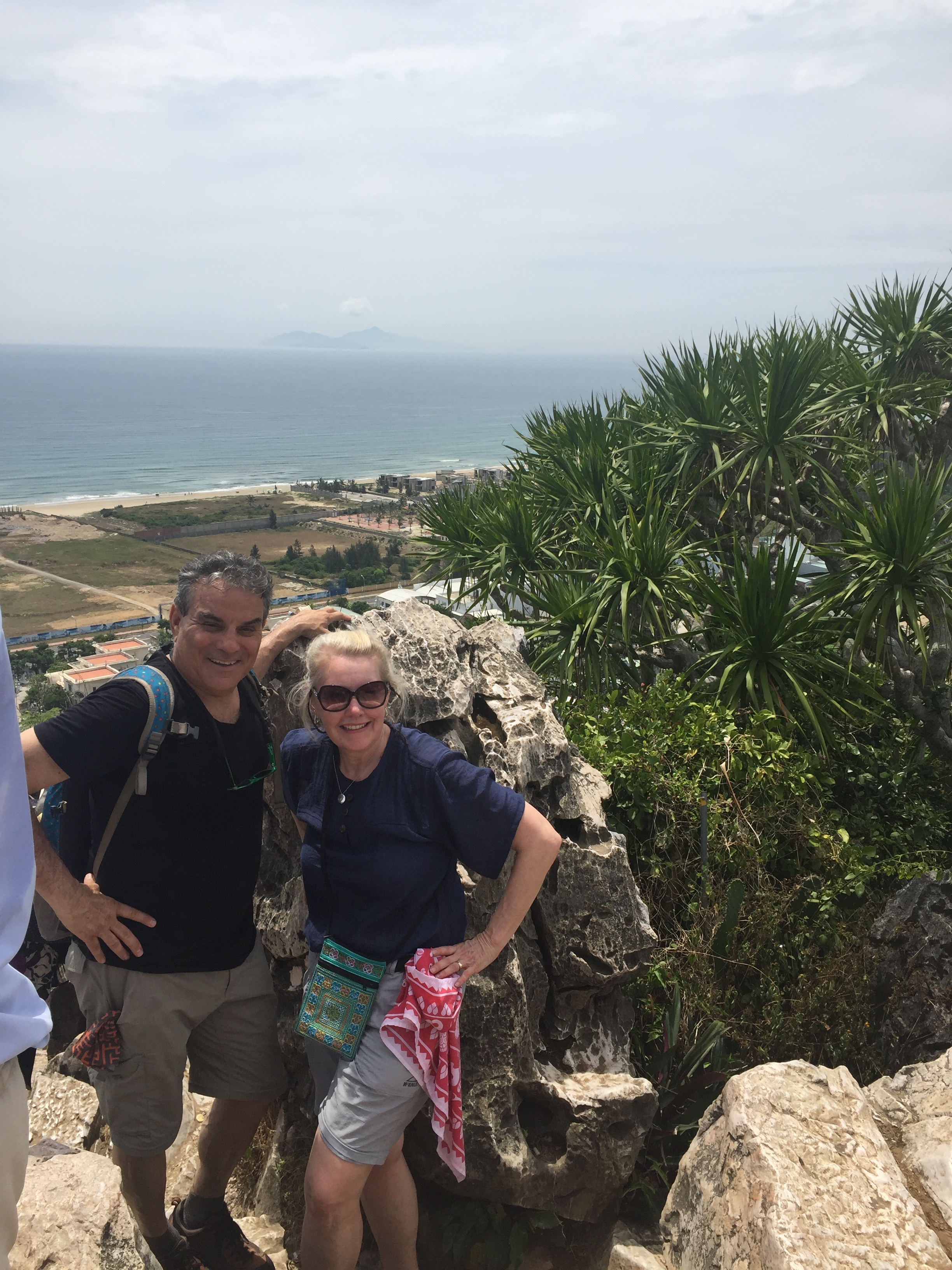Hue
Hue with population of 348,000 is located in north-central Vietnam about 150 KM from the former De-militarized Zone (DMZ) that separated north and south at the time of the “ Unification War” aka “American War”. Hue was the former Imperial Capital of the Nguyen emperors, where both ancient and most recent Kings lived. Palaces and pagodas, tombs and temples of the “Nguyen” emperors are the real draw to this area.
The Hue sunset from our hotel window
We flew VietJet Airlines from Hanoi; it was interesting to see a group of Monks traveling with us in their brown gowns. The flight was a quick 1 hour. Upon arrival, Mr. Bien from the hotel picked us up making the transfer easy. The Orchid Hotel was another cute boutique locale with great staff that offered a variety of tours. We chose the all day “Citadel Tour”. Most of the architectural and imperial attractions are across from us on the north side of the “Perfume River”. Starting at 8:00 AM, we are picked up and taken to the docks for our “Dragon Boat” ride down the river to a religious Pagoda. Immediately, we can tell our small group of six is going to be a winner; our team includes Aussies David and Allison and two young lady doctors from the UK. Our guide, Ha’ng , with her ball cap and scarf is a bubbly gal and very knowledgeable. We are told the decorated dragon boat is owned by the captain and doubles as his family home. We see first hand evidence of this as a one month old baby and new mom sit in the slightly separated living quarters. The Perfume river is calm and the boat ride fun.
Thien Mu Pagoda
We dock at the Thien Mu Pagoda. This is a religious site built overlooking the Perfume River. The centerpiece is the 21 meter tall octagonal tower with seven stories dedicated to “ Manushi-Buddha” (a Buddha that appeared in human form). It was constructed in 1844 by Emperor Thieu Tri, and still functions as a monastery for Buddhist Monks. The monks take in orphans and troublesome kids. Apparently there was an issue with the communist regime curbing the Buddhist faith. So the Most High Monk exited his blue car, a displayed relic, and set himself afire in protest. We guess it worked.
Citadel
Our van caught up with us and we drove to the “Citidel”. Built in 1804 and then again in 1833 this is a giant royal estate heavily fortified with high walls 10 KM- long and with 10 gateways. The Citadel has different sections. We first saw the Mang Ca fortress and military base with those 2-meter thick walls and moat. We moved through the endless grounds to the Imperial Enclosure and then the Forbidden Purple City. On the vast grounds are Temple compounds, residences, and gardens.
The inside entrance
We enter the Imperial Enclosure, a citadel-within-a- citadel, through the side doors of Ngo Mon Gate reserving for the Emperor the use of the yellow doors, now long closed. This area houses the Emperor’s residence, temples, places, and main buildings of State government. Only 20 of 148 buildings remain intact after a series of wars; French and American. The “Palace of Supreme Harmony” survives since 1803 and this large structure with ornate roof supported by 80 carved columns was the place of official receptions and ceremonies.
Royal Theater
The Emperor’s Reading Room was the only part of the “Forbidden Purple City” that was not damaged and is under restoration; a two story structure it has interesting roof mosaics.
We especially enjoyed the “Royal Theater” which at the time was closed for rehearsal. Security let our guide in and we just followed to view the large multi story hall that was the home of the National Conservatory of Music.
New Market
We returned to the van after several hours. After being outside all morning the sun and heat starts to amp up. We need some cool relief and to our glee the guide passes out icy cold wash clothes and chilled water. Instantly refreshing. Off we go to theMarket. Our guide walks us through the covered market pointing out the weird fish stuff, fruits and veggies. We always like the energy and sights of markets. This was probably our 24th market give or take.
The Market
We now stop for lunch and have first class food and fellowship. Our new Aussie friends had traveled for many years on their sailing yacht fixing stuff that broke on the way. They then turned all that experience into an outfitters company for boats. It sounded like a grand transition. They also gave us many suggestions for fun things to do in Australia. We think we will probably take the train for the Blue Mountain excursion.
Lunch was really good. We continued our van trip to the the Tombs of two Kings of the longstanding Nguyen Dynasty near the Perfume River:
Royal Tombs
Hue has 9 tombs of the rulers of the Nguyen dynasty. We visited 2 with our tour. First the tomb of Minh Mang. Emperor Minh Mang designed the tomb for himself; constructed 1864--1867, but completed by his son. It is a huge complex with several man made lakes. The actual burial site of his tomb is still unknown today and they say his treasure remains with him.
Our second was Khai Dinh’s Tomb. This is the last emperor and the tomb was completed in 1931. Smaller but equally impressive is this hillside Tomb with grandiose exterior of formed concrete that creates a gothic style of European influence, as the Emperor had interacted with the French much of his life. The interior uses colorful mosaic patterns. This tomb was our favorite.
To end the day we stopped at a small roadside craft store with various items being hand made and sold. Frank agreed to roll some brand new “incense “sticks. After quick instruction the first two sticks rolled off the assembly line.
This was really a fun day.
Our happy tour group
On our last day in Hue we set off to explore 2 more tombs without a guide. Taking a taxi we went to the tomb of Tu Duc. Most guide books list this as the most impressive of the tombs and we were not disappointed. Tu Duc designed the tomb for himself; constructed 1864--1867, but at such enormous expense and forced labor that a coup arose against him that he did crush. The grounds and buildings rendered this future resting place one of the most impressive. Tu Duc himself lived a life of imperial luxury including carnal excess with 104 wives and many more concubines, but no kids, so no heirs. Our guide says that historically, the mother of the favorite son who was to be named as the future King, took the title of Empress only after her son took the throne over from the departed father. Succession to the throne was not automatic to the first born. See a few pics from the site.
The second tomb for the day was in disrepair, but was being renovated slowly. The most interesting thing for us, we were the only ones there, was to walk through the reconstruction and hardware in the building and around the grounds. Quick and fun—then back to the cab and Hotel Orchid. It was a fun hot day. After 4 months of cold Europe we are still adjusting to 100 degree heat and humidity. Thankfully every corner has a great spot to eat and get really cold beer.
Hoi An
Next day we took the “Open Bus” for tourists to go to Hoi An. The strangest configuration. “Major Tom to Ground Control”. The seats were set up like bunk beds, passengers lay back in a semi-prone position. Hard to use a lap top when laying on your back. We could not do work, so we plugged in the splitter and listen to a dramatic audio novel. Time flew and we arrived in Ho ai at a street side stop. We walked to our hotel using Google Map. The Silk Boutique Hotel and Spa is really nice, and it has a pool, zero edge, which we have now come to need desperately after several hours in the heat on excursions. The staff is super friendly. This is the definite pattern in Vietnam. We set up tomorrows ½ day tour to the Marble Mountains, Monkey mountain, and the Lady Buddha Pagoda and Temple.
Today, we will finish the afternoon by walking over to the Old Town, crossing the covered bridge, and taking in the local flavors. The Old Town is very cool. Two bridges cross the river to Old Town that sits between forks of the Hoai River, like a peninsula. The old town has three major streets with shops, restaurants, art galleries, clothiers & tailors, and historic Assembly Halls constructed by the Chinese; in the past Chinese have governed Vietnam off and on for thousands of years. We specifically looked for and ate at the “Nu Restaurant”, a hole in the wall place but cute. We had a series of appetizers to share and the food was exceptional. Frank tried a new beer brand. He has drank Tiger, 333, Larue, and Saigon named beers. We will return in the evening to see “ Buddha Birthday” celebration that is continuing throughout the country. What is the Hoi an version?
Buddha Birthday Party
Sunset has come. We got by the main entrance check point because we had already purchased the Combo Old Town Ticket & Museum Pass. The river front was brightly lite up with historic religious figures like the Dragon, Unicorn and Tortoise. The lighted Lotus Blossoms were floating in the river as a symbol of Buddha’s birth and his 7 steps on the floating lotus. Crowds were gathering.
We walked river side and then crossed back and forth over the bridges with the crowds to check out all the stores. We found a nice restaurant and sat in the open window with a fan on our backs. This was again some of the best specialty foods we had eaten. Enjoy some photos.
On our final day we walked back to old town to check some of the ancient dwellings we had not seen before. Again in cutesy of the suggestions of the prior guide. First, we went to Quang Trieu Assembly House and the Phuc Kien Assembly Hall; both of these were built by the once occupying Chinese as a place for their merchants to meet. The buildings where brightly decorated with reverence to Buddha and many places to sit. We then went to ancient Vietnamese homes called “Old House of Tan Ky” and “Tran Family Chapel”.
Both were interesting with photos and urns at the family alter, as explained by an on-site guide.
We walked to the fishery part of the river front. Wow, that smell! We moved along quickly to a street food vendor of note in the Lonely Planet, called the “ Hi” Restaurant, known for cooking courses. We ate, staying in the shade until 2:00 pm, before we strolled to the Orchid Hotel for pool time. We stayed in to pack and do some planning for the next stop in Ho Chi Minh City ( Saigon).
Danang
Pop 944,000. It was particularly interesting driving around the area and seeing the fantastic beaches and docked fishing boats. Danang sits on the Han waterfront. It was called “China Beach” during the American War and the strip is the fastest changing place in Vietnam with high-rise hotels and beach resorts.What really turned our head was the continued rustic existence of the US Danang Airbase. The cement fence runs for ever and there are many dirty yellow cement Quonset Huts observable from the street. Surprised again when we later flew to Ho Chi Minh City (Saigon) from the new Danang Airport , the civilian take off runway ran by the old Fighter Jet Parking Zone.

